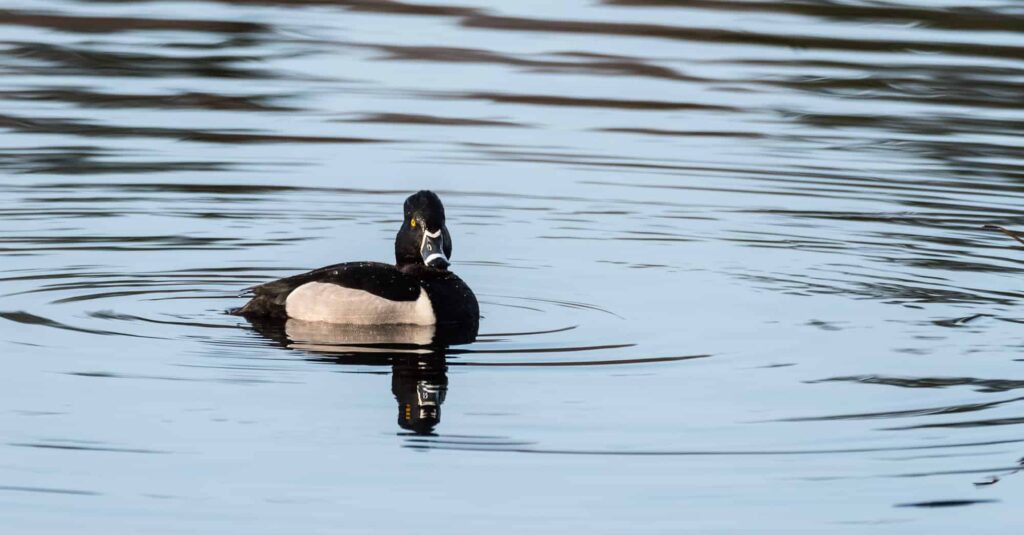Kansas is home to large cities, sprawling agriculture, incredible state parks like Wilson and Cedar Bluff, woodlands, rivers, lakes, and more.
Living in this diverse range of habitats are numerous types of birds, including 27 different kinds of ducks. More than 470 types of birds have been documented in Kansas.
There are duck species that live in Kansas year-round, as well as ducks that are only here in the summer, the winter, or during the brief migration periods that occur every fall and spring.
The Kansas Department of Wildlife and Parks provides a list of these ducks, but we want to provide something far more detailed and helpful so that you can find, identify, and document these interesting members of the avian world.
Identifying Ducks: Tips & Tricks
Learning to identify ducks is not that different from learning to identify any other bird. You will still look for the same kinds of features and behaviors that you would look for in other birds. If you’re unable to get a great picture, consider taking some notes about the following features of the duck:
- How big is it? (Size, weight, length, and wingspan are ideal, but since you can’t get up close, try to compare it to other ducks in the area to determine if it’s larger or smaller.)
- What is its shape/silhouette? (Does it have a sloping forehead, a crest, a pointed tail, a rounded head, a bulbous bill, a serrated bill, etc.?)
- What is its habitat? (Was it spring, summer, fall, or winter when you saw the duck? Was it in the water or on land? What kind of water was nearby — brackish, freshwater, slow-moving, deep, shallow, muddy, etc.?)
- What are its color patterns? (Pay attention to the color and patterning of the head, wings, breast, back, bill, eyes, tail, legs, and feet. The more you can document, the easier it will be to identify the duck!)
Dabbling Ducks, Diving Ducks, and More
Ducks are generally divided into two categories based on how they forage for food.
Dabbling Ducks dunk their heads underwater and stretch out their necks to reach their food, leaving their little tails bobbing up and down in the water, pointed toward the sky.
Diving Ducks, on the other hand, submerge themselves completely under the water to get their food. They will disappear for about 30 seconds at a time, although some ducks will dive for much longer. The Long-Tailed Duck will submerge itself up to 200 feet below the surface to chase its prey!
Sea Ducks are another category of duck, but they are more like a subcategory of Diving Ducks. They dive, but they also spend a large part of the year in deep, coastal waters.
We have labeled each duck in our list as a Dabbling Duck, a Diving Duck, or a Sea Duck. Just keep in mind that Sea Ducks are also Diving Ducks.
Let’s take a look at the ducks that have been documented in Kansas, including incredibly common and relatively rare species!
American Black Duck (Dabbling Duck)
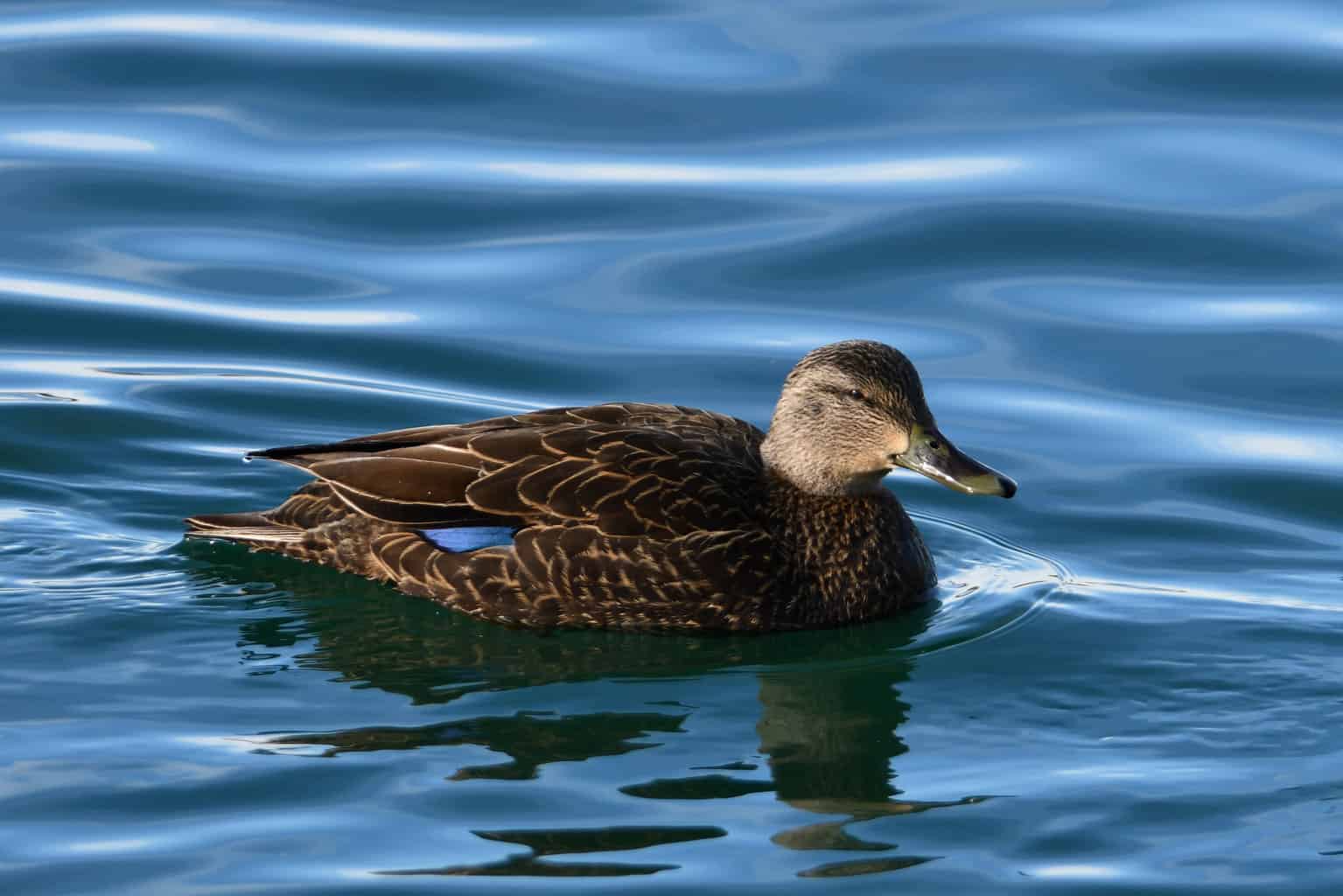
- Anas rubripes
- Length: 21.3-23.2 inches
- Weight: 25.4-57.9 ounces
- Wingspan: 34.6-37.4 inches
Most of the ducks on this list are strongly sexually dimorphic, which means that the male and female look very different from one another. That’s not the case with the American Black Duck. While they are technically dimorphic, the male and female look very similar.
The male American Black Duck is darker brown than the female. He has a greenish-yellow bill, whereas hers is just green. Males and females have white underwings. The speculum on both sexes is purplish-blue.
American Black Ducks are almost exclusively found in the eastern half of North America, and Kansas is the far western edge of their habitat. They don’t visit the western half of the state, but you may be able to find them in both the Southeast and Northeast regions during the winter.
American Wigeon (Dabbling Duck)

- Mareca Americana
- Length: 16.5 – 23.2 in (42 – 59 cm)
- Weight: 19.1 – 46.9 oz (540 – 1330 g)
- Wingspan: 33.1 in (84 cm)
American Wigeon males are gray-bodied with green stripes on their heads and a pale bill with a black tip. They have a white cap, giving them their nickname of “The Baldpate.”
Females, on the other hand, are brown, and their heads are grayish-brown. Their bills are pale in color, as well, and also tipped in black.
American Wigeons live throughout Kansas in the winter. Their winter habitat includes lakes where there are plenty of aquatic plants. They eat insects, plants, and invertebrates, which are abundant in many of Kansas’s lakes and ponds.
Barrow’s Goldeneye (Diving Duck)
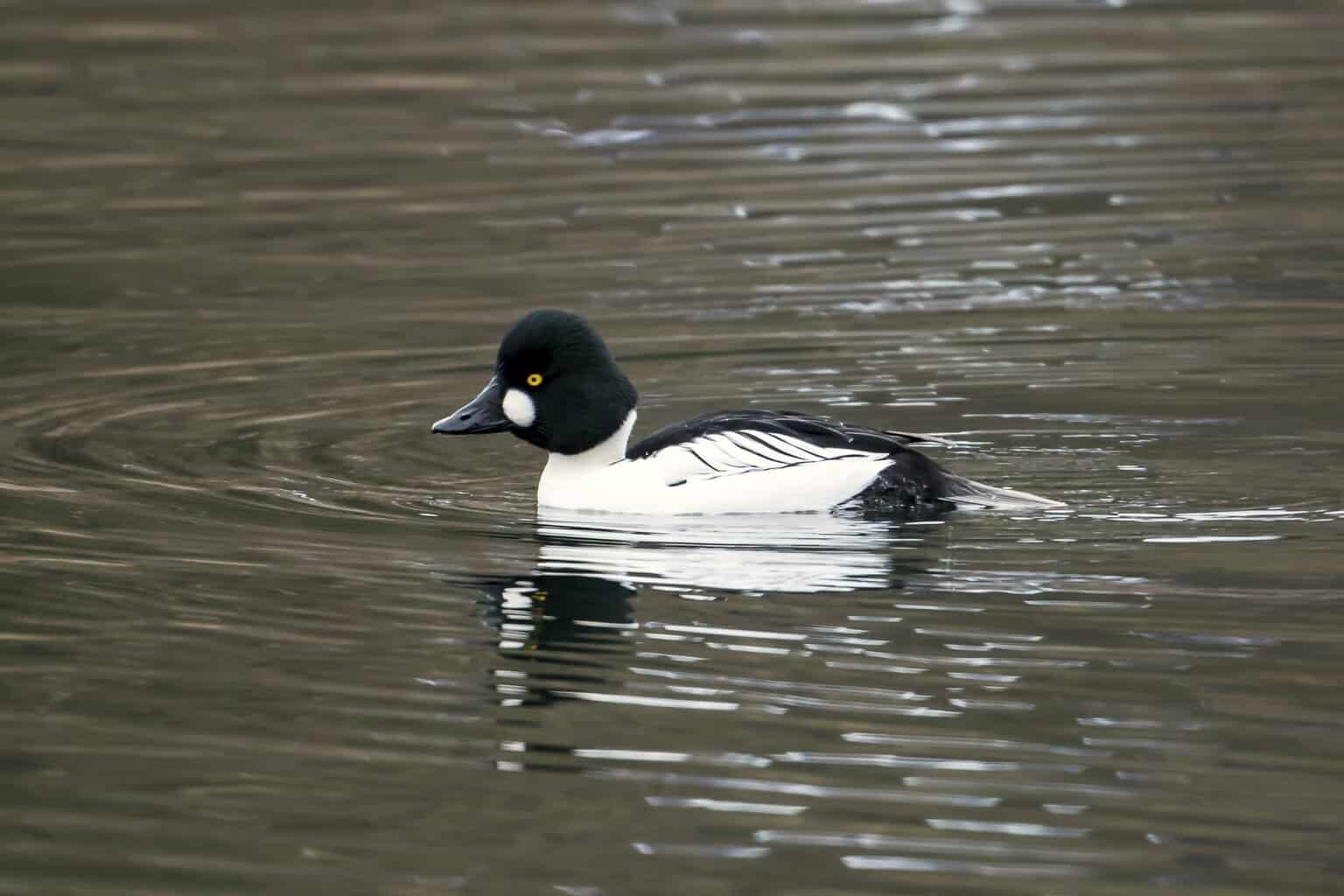
- Bucephala islandica
- Length: 16 – 20 in (41 – 51 cm)
- Weight: 38.4 oz (1088 g)
- Wingspan: 30 – 32 in (76 – 81 cm)
Goldeneyes are named for their yellow eyes. There are two kinds of Goldeneyes in Kansas: the Common and the Barrow’s.
The male Barrow’s Goldeneye has a very dark head that looks black from a distance but is actually dark purple. He has a white crescent marking on his cheeks and white, square-shaped markings on his wings.
The female is gray with a dark brown head. She has a white ring around her neck and a yellow-orange bill.
Barrow’s Goldeneyes aren’t regular visitors to or residents of Kansas, but they have been documented in the state a number of times, especially in the east. They live in abandoned nest cavities — especially those left behind by Northern Flicker woodpeckers.
An interesting fact about Barrow’s Goldeneyes: because their diet is made up entirely of insects, they do not live in bodies of water where the fish eat insects. That would create too much competition.
Black Scoter (Diving Duck)
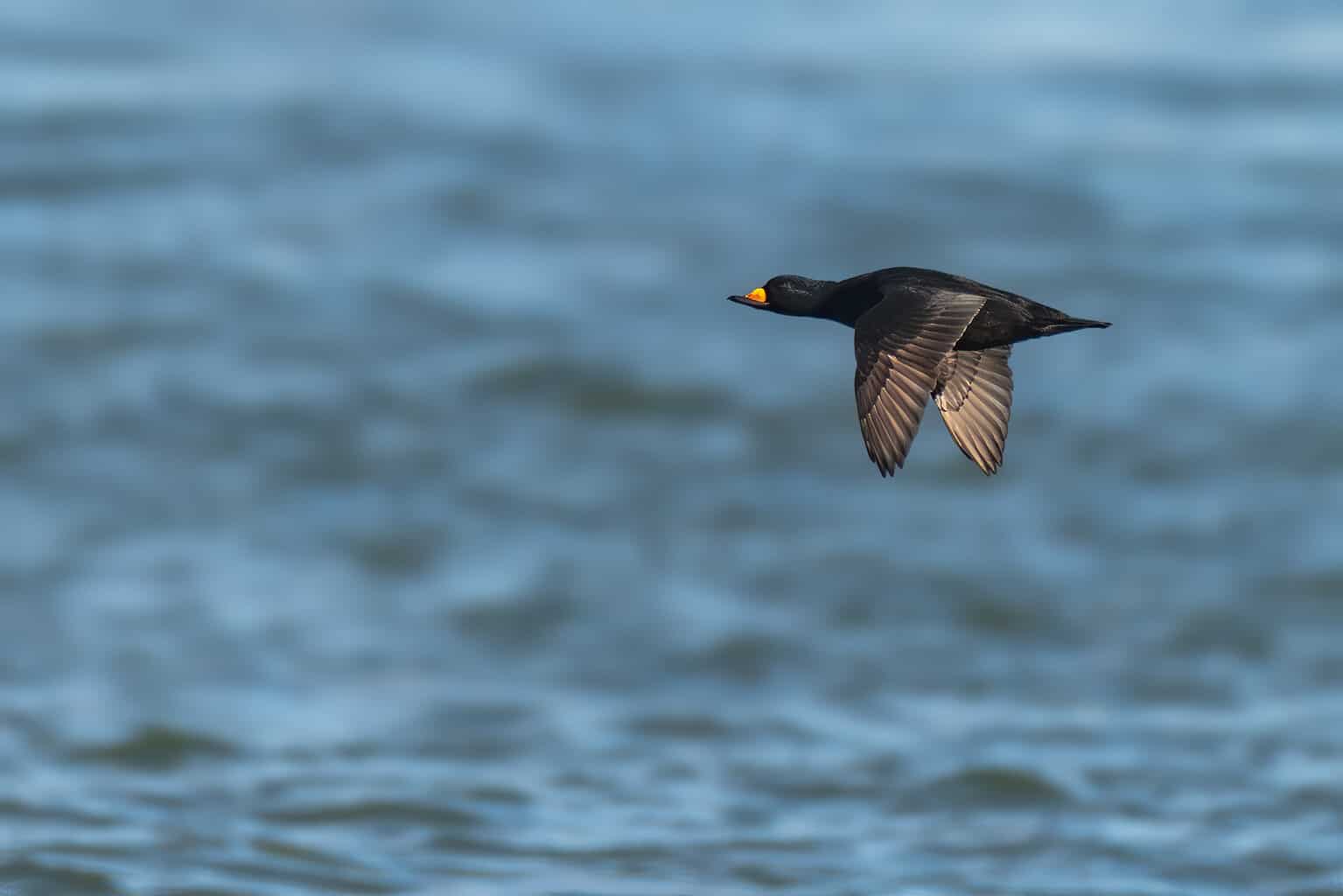
- Melanitta Americana
- Length: 127 – 21 in (43 – 53 cm)
- Weight: 387.4 oz (1088 g)
- Wingspan: 30 – 35 in (76 – 89 cm)
There are multiple kinds of scoters in Kansas, including the Black Scoter.
The male Black Scoter is all black. That includes his eyes, body, and wings. However, he has a big orange bulge at the base of his otherwise black bill.
Females are mottled in light brown and have dark brown crowns. They also have gray cheeks and lack the orange bulge on their bill.
Black Scoters are not typical visitors or residents of Kansas, as they tend to stay on the far northern Atlantic and Pacific coasts. However, they will sometimes show up in Kansas as an accidental migrant.
Blue-Winged Teal Duck (Dabbling Duck)
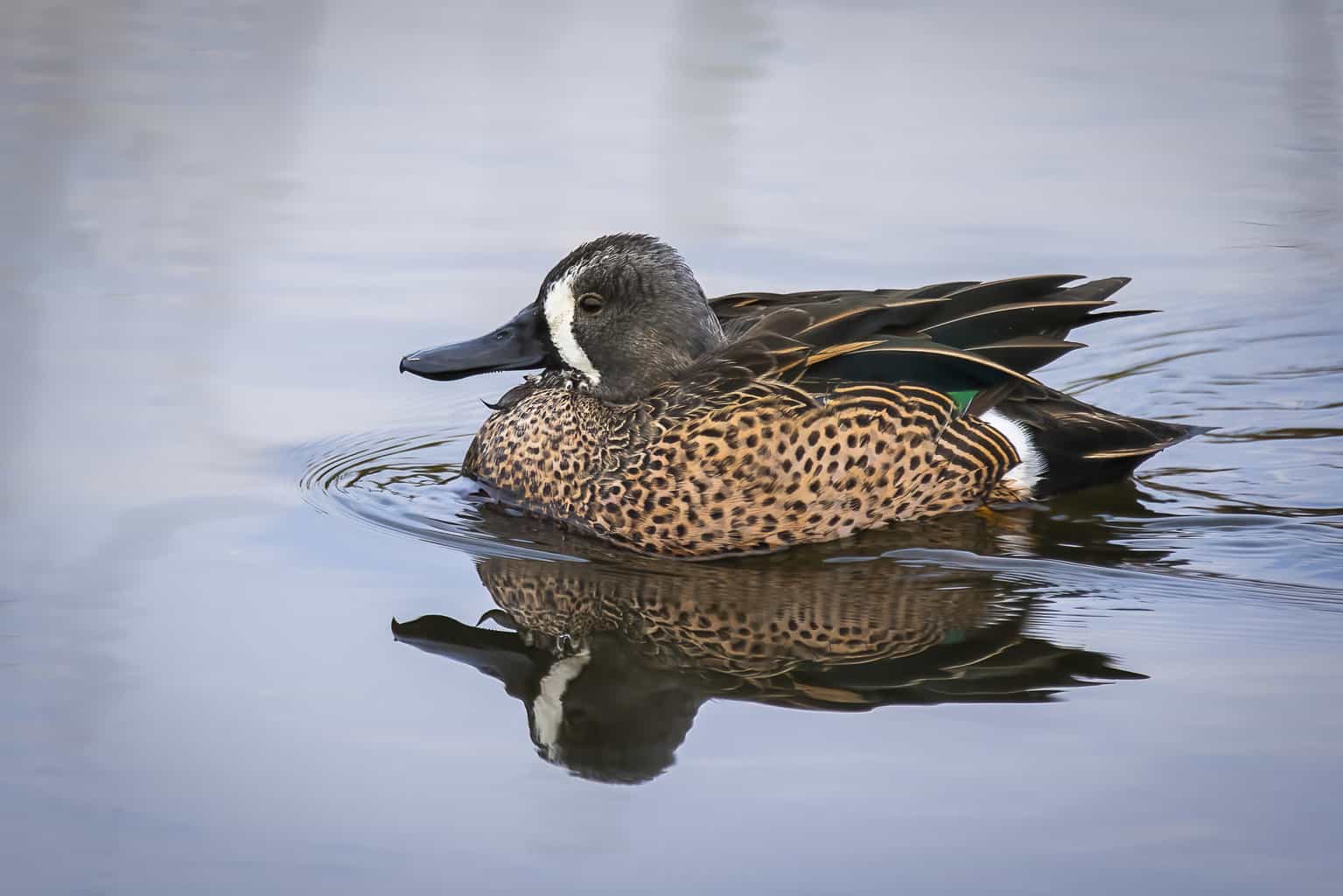
- Spatula discors
- Length: 15 – 17 in (38 – 43 cm)
- Weight: 19.18 oz (544 g)
- Wingspan: 23 -31 in (58 – 79 cm)
The Blue-Winged Teal Duck is a small dabbling duck that breeds across Canada and much of the United States.
Males have a brownish-gray head, a brown body, and a white crescent marking in front of their eyes. He has a blue patch on his shoulder and a green speculum. Females are spotted, like males, but they lack the white crescent on their faces.
Blue-Winged Teal Ducks live in Kansas during the breeding season. They are found throughout the state, and they nest in tall grasses, near calm waters. They like ponds with plenty of aquatic plants.
Blue-Winged Teal Ducks are of special interest to biologists thanks to two unfortunate reasons: they have very high mortality rates (likely because of their long migrations), and they may be responsible for spreading avian influenza to commercial poultry farms.
Bufflehead (Diving Duck)
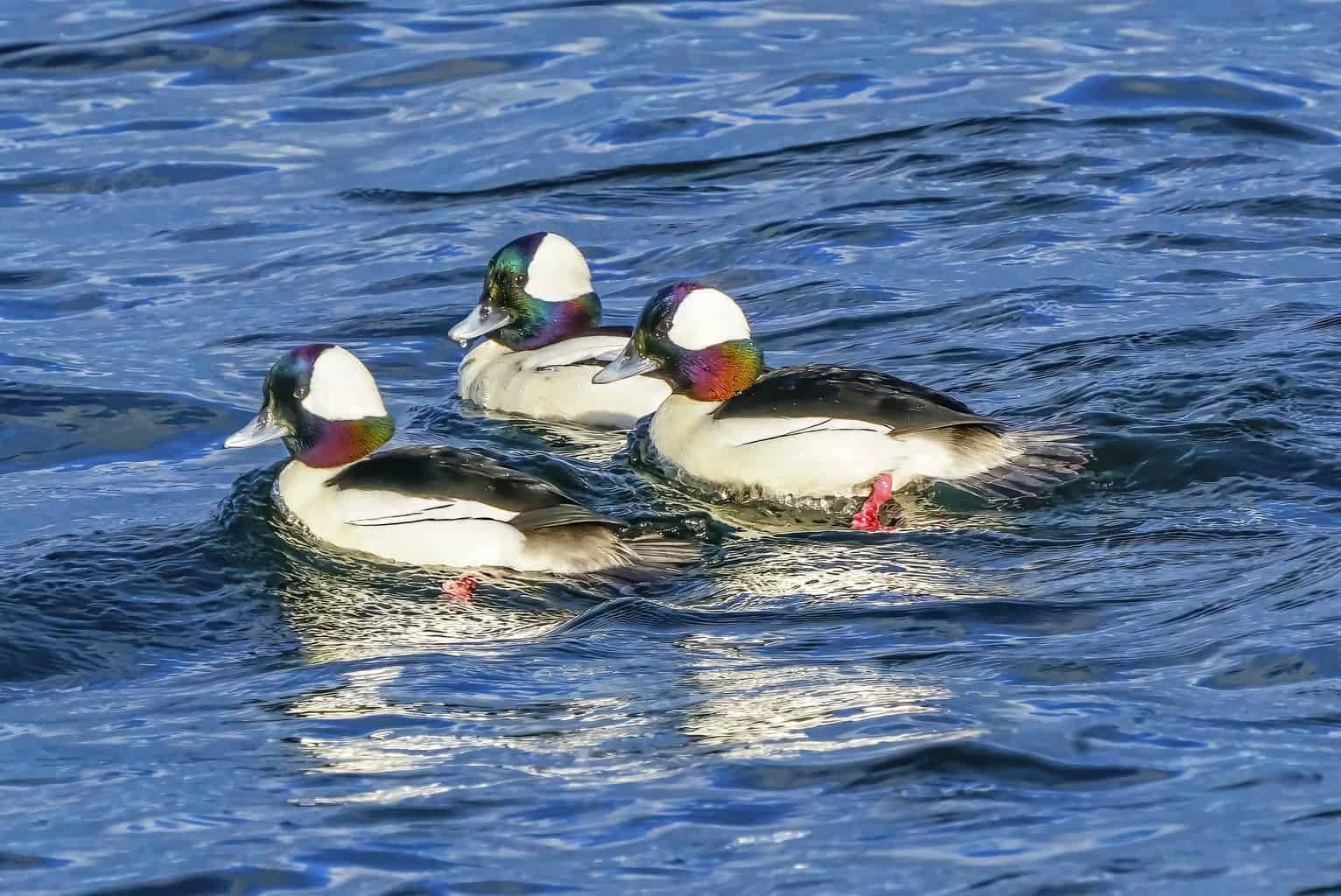
- Bucephala albeola
- Length: 13 – 16 in (33 – 41 cm)
- Weight: 21.16 oz (600 g)
- Wingspan: 20 – 24 in (51-61 cm)
Bufflehead males are mostly black and white, but their head is multi-colored. There is a large white patch that fans out from the eye to the back of the head, and on either side of this white patch are iridescent green and purple sections.
Females have gray and black bodies, dark brown heads, and a white cheek patch.
Both sexes have large, rounded heads that give them their name. Think of the way a buffalo’s head is fluffy and large compared to the rest of its body, and the connection will make sense!
Buffleheads are tree cavity dwellers, but they will also accept nest boxes. They live in forests that are mixed with coniferous and deciduous trees. As winter residents of Kansas, you are most likely to see them in quiet, still ponds.
Canvasback (Diving Duck)
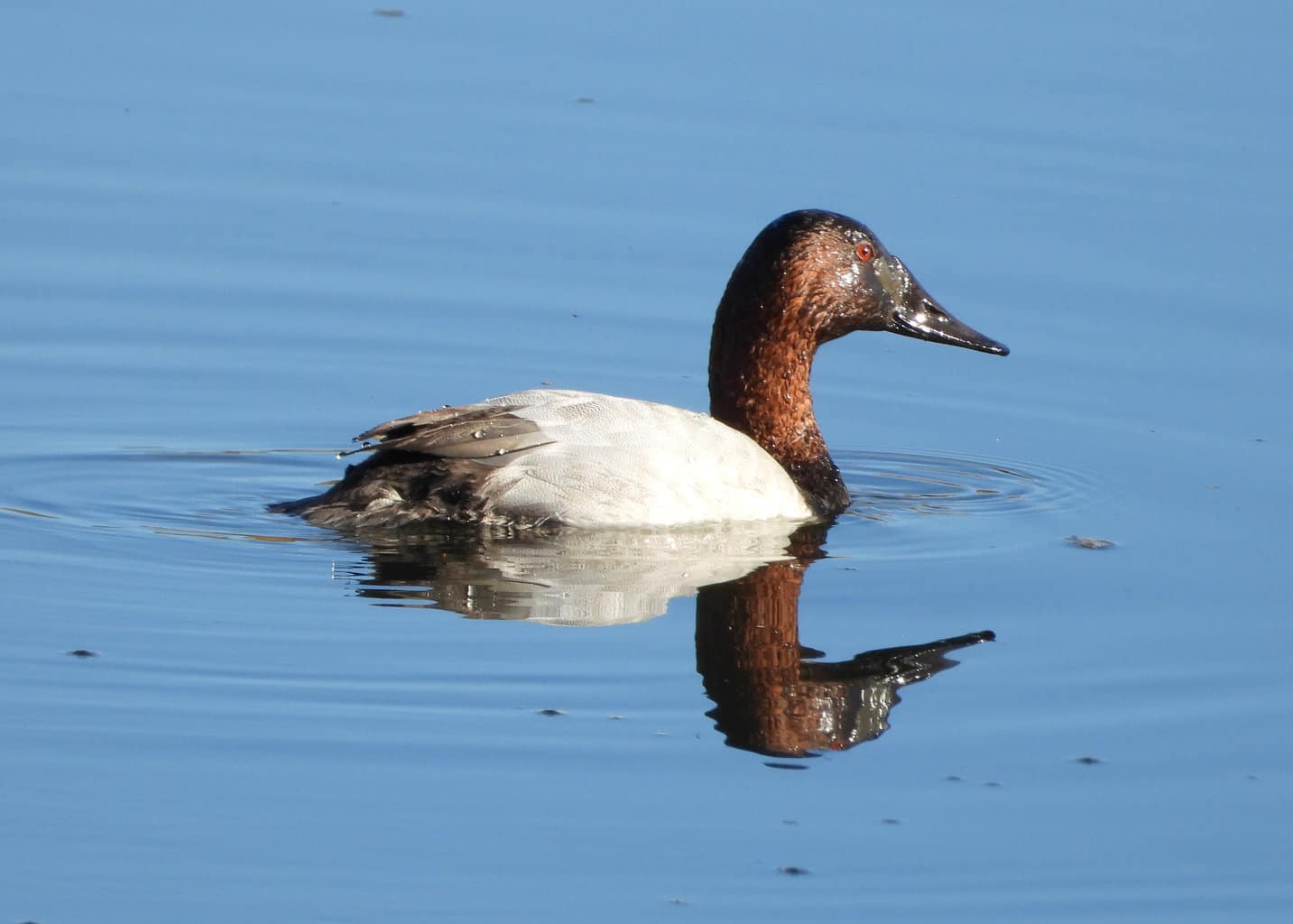
- Aythya valisineria
- Length: 19 – 24 in (48 – 61 cm)
- Weight: 58.48 oz (1657 g)
- Wingspan: 28 – 36 in (71 – 91 cm)
The Canvasback has very distinctive markings. The male’s head is dark, coppery-brown, which contrasts with his black chest and light, canvas-gray body. His eyes are red, and his forehead slopes down to a large black bill.
The female is light brown, with a darker brown back. She has minimal markings and black eyes. The top of her head is dark brown, and she has the same sloping forehead as the male.
Canvasbacks spend the winter throughout Kansas. If you see them on the water, you may notice their size first: they are the largest diving ducks in North America. They prefer marshes with plenty of aquatic plants and invertebrates.
Cinnamon Teal Duck (Dabbling Duck)
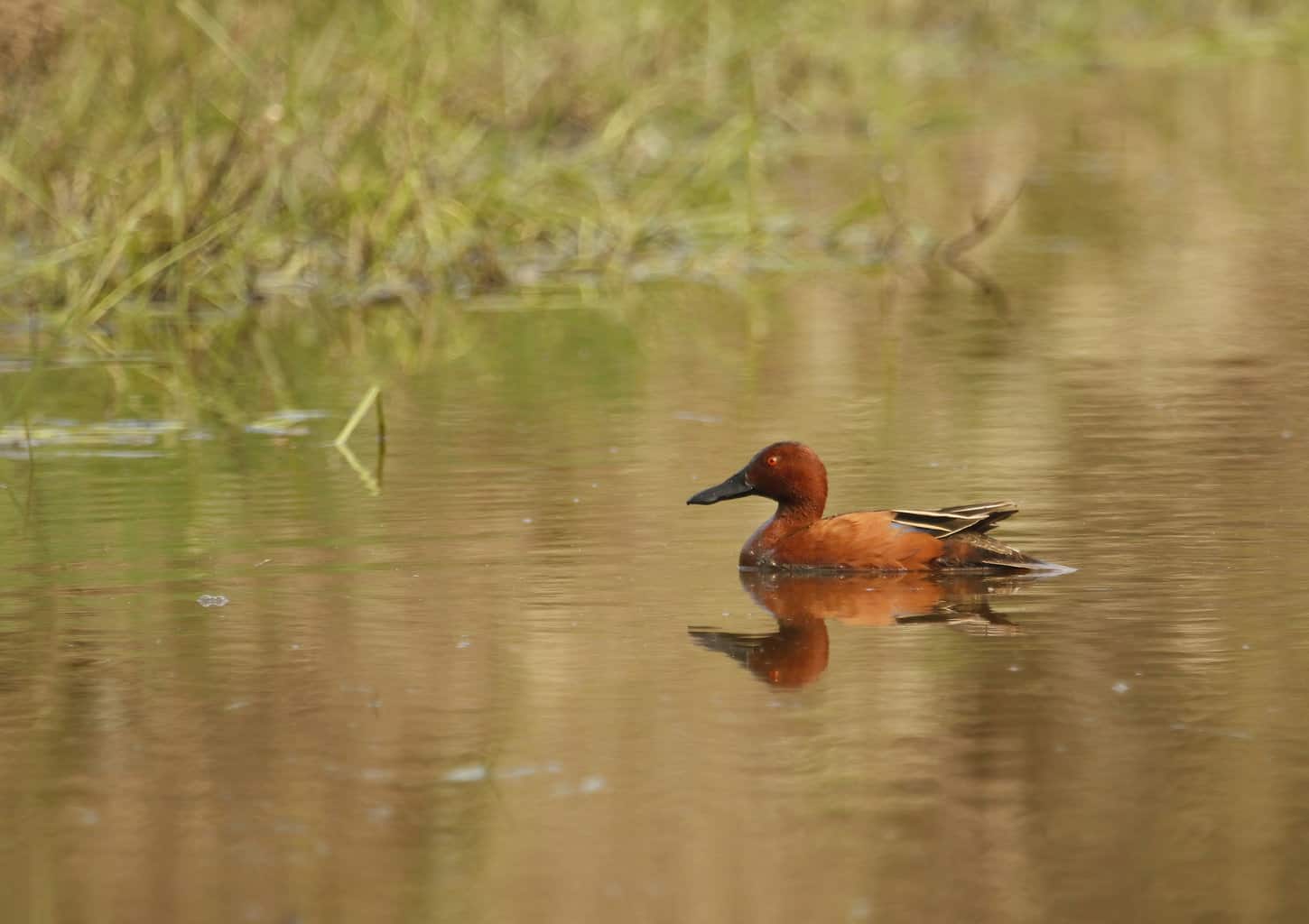
- Spatula cyanoptera
- Length: 14- 17 in (36 – 43 cm)
- Weight: 16.4 oz (465 g)
- Wingspan: 24 – 30 in (61 -76 cm)
Cinnamon Teal Ducks are one of the many species of ducks that change their appearance between summer and winter. Because they are so vibrantly colored in the summer, the difference between breeding and non-breeding season can be striking.
During the summer, males are dark reddish-orange. They have a pale blue shoulder patch and green speculum, and a body that is often described as “burnt cinnamon” in color.
By winter, they molt and replace their vibrant feathers with much paler ones. It can be difficult to distinguish between male and female Cinnamon Teal Ducks during the winter months. Females and non-breeding males are plain brown with some mottled scaling across their feathers.
Cinnamon Teals aren’t common in Kansas. They are accidental migrants, which means that individuals or pairs will sometimes end up in the state, but not on purpose, and not consistently. They usually stick to the west coast and American southwest.
Common Eider (Sea Duck)
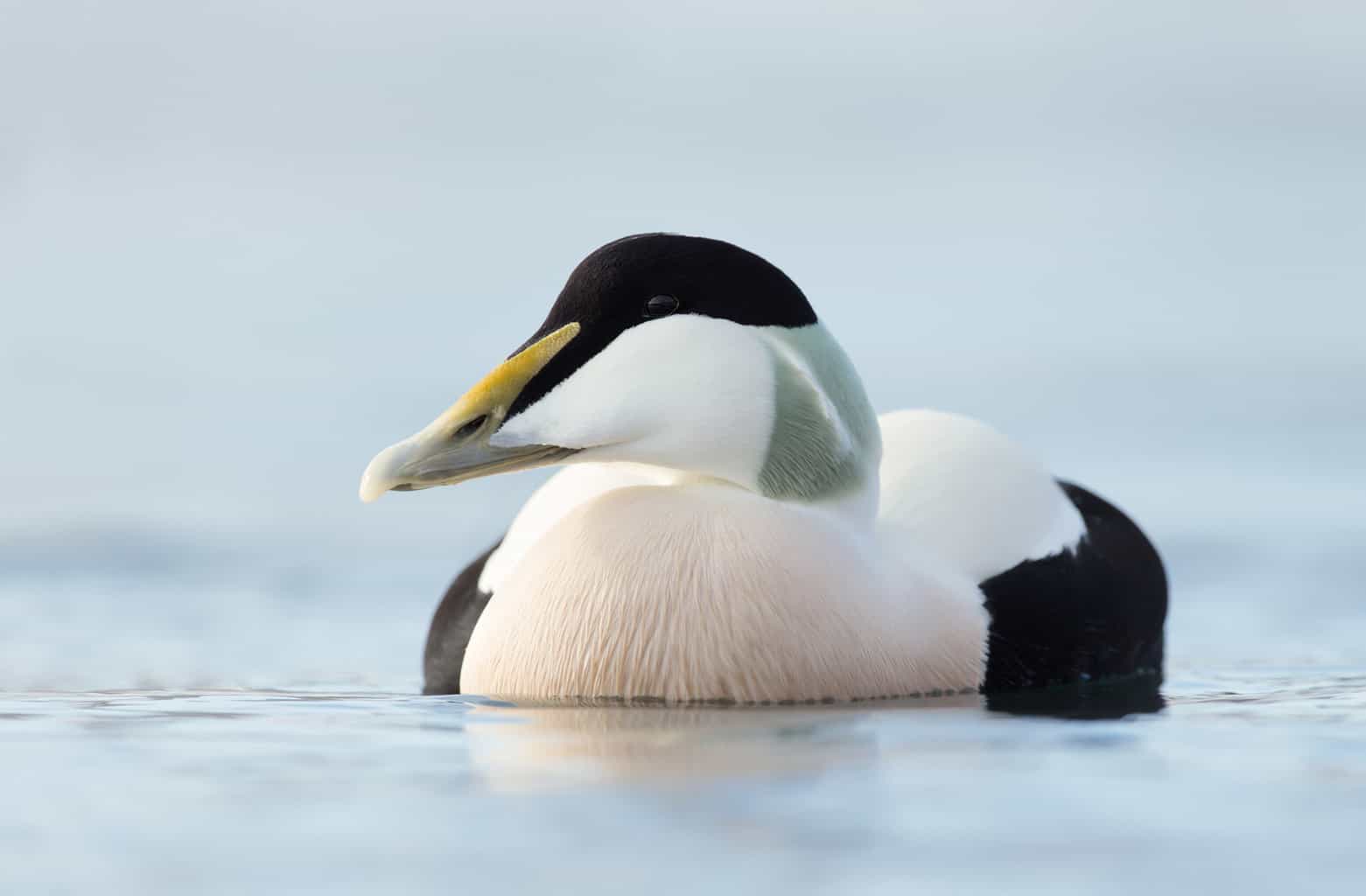
- Somateria mollissima
- Length: 19.7-28.0 in (50-71.1 cm)
- Weight: 45.9-92.1 oz (1300-2611 g)
- Wingspan: 37.4-38.6 in (95-98 cm)
The male Common Eider is black and white, with a black crown and pale green on the back of his neck. His bill could be yellow or greenish-yellow, depending on the individual.
Eiderdown is incredibly soft and valuable, and it is still collected from nests in Canada and Iceland for use to fill pillows, coats, and other items. Eiderdown collection is governed by strict international and national laws.
Eiders are interesting because they tend to live almost exclusively along North American coastlines, but they also show up in many states’ duck lists because of their migration habits.
As medium-to-long distance migrants, they make stops during their travel and end up in many states where they don’t spend any significant amount of time.
Even though the Kansas Department of Wildlife and Parks lists the Common Eider as a duck that can be found in the state, I could only find reference to one individual ever recorded in the state — all the way back in 1891!
If you were to see one of these incredibly rare ducks in Kansas, document it well and submit your observations to the eBird website.
Common Goldeneye (Diving Duck)
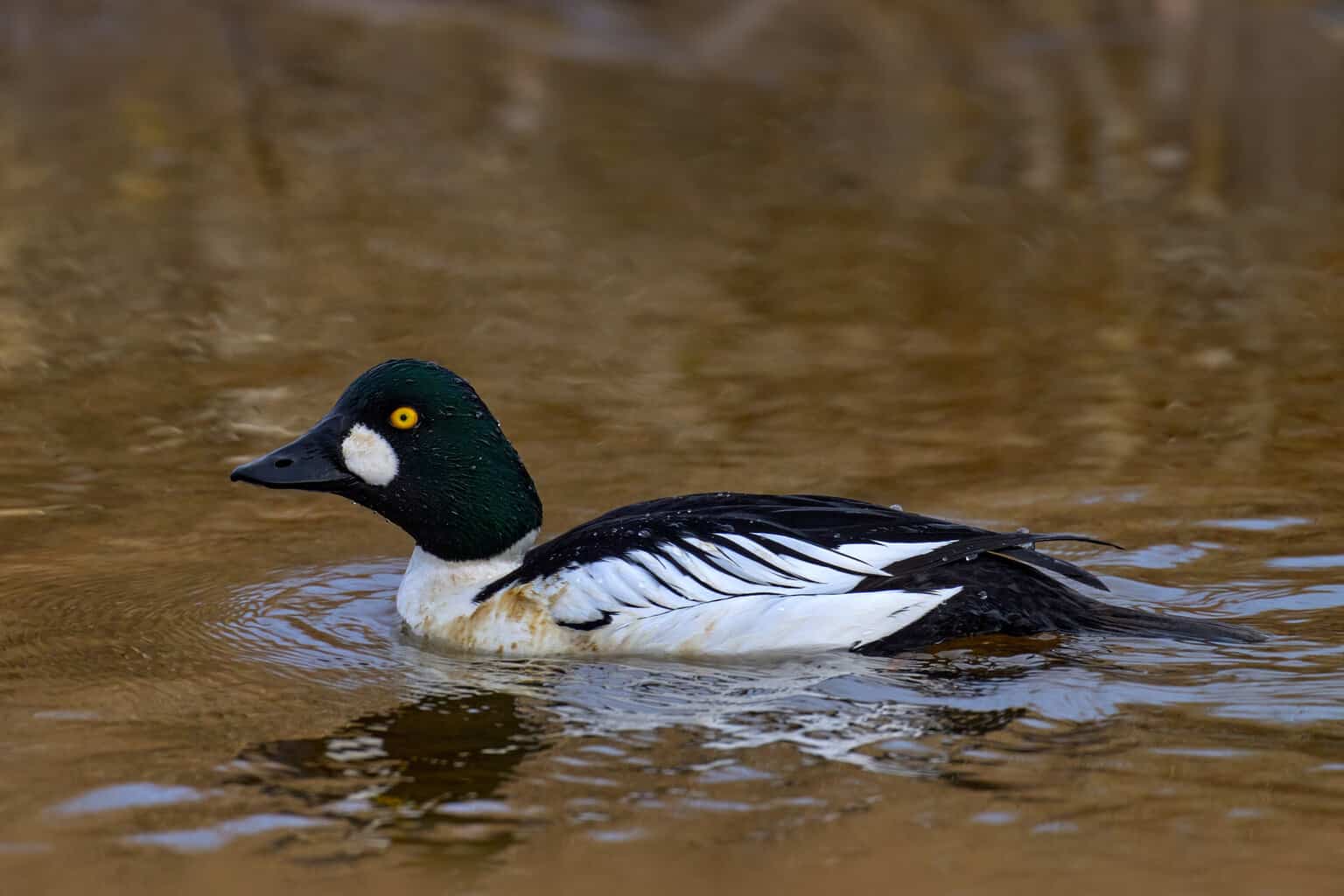
- Bucephala clangula
- Length: 16-20 inches
- Weight: Approximately 1.8 pounds
- Wingspan: 30.3-32.7 inches
The male Common Goldeneye has yellow eyes, an angular green head, and white patches on both his cheeks and wings. The female is gray-bodied with a brown head. She does not have a cheek patch, but she does have a white patch on her wings.
Common Goldeneyes are found in Kansas during the winter. They are relatively widespread, rather than being limited to just one part of the state. You will typically find them in forested lakes and rivers.
Common Goldeneye females are territorial, to the point that they will fight with other females to protect their “brood territory.” This sometimes causes the ducklings to get separated from one another. They may find their way to another nest, where they are raised by a different female.
Eurasian Wigeon (Dabbling Duck)
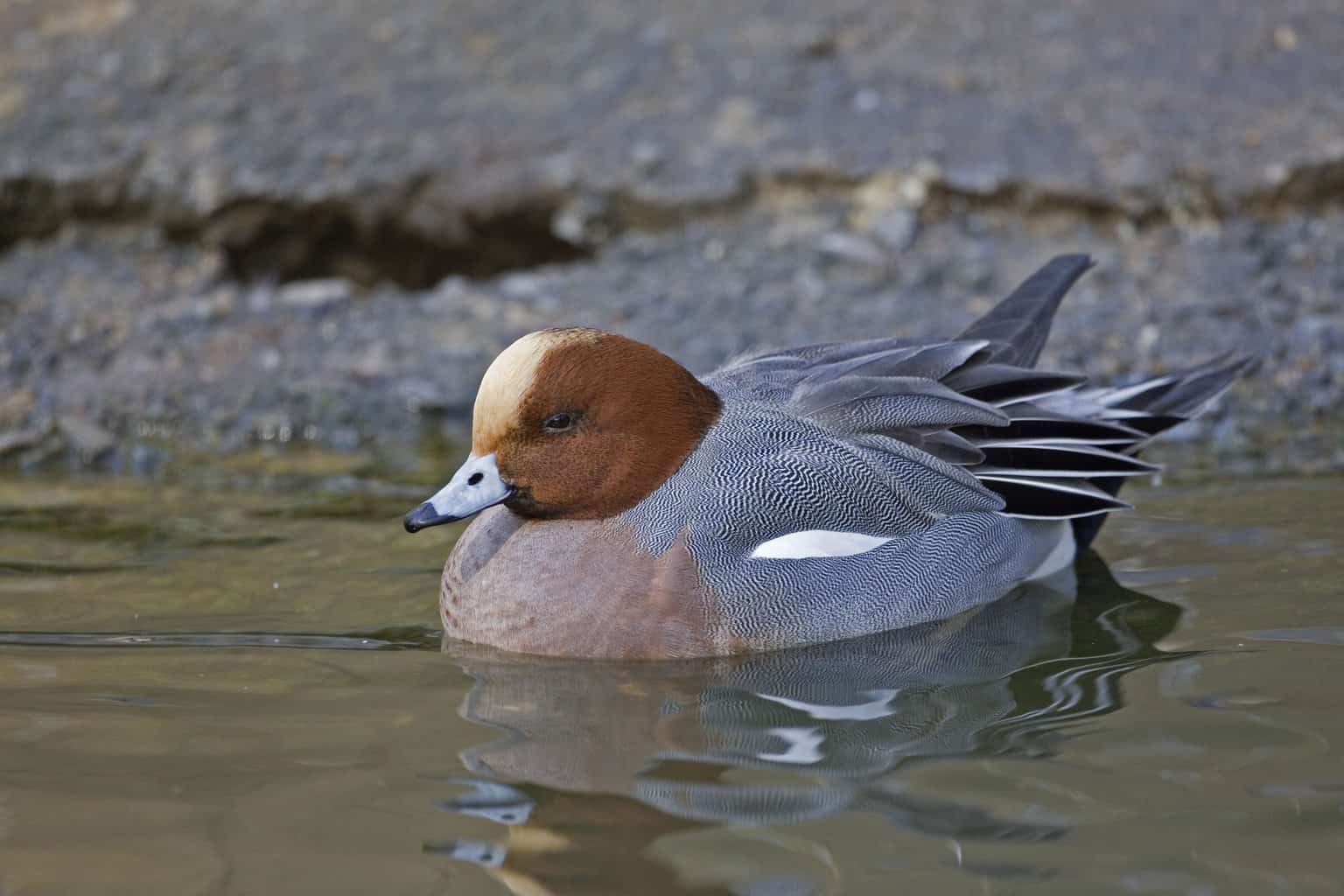
- Mareca penelope
- Length: 17-20 inches
- Weight: 1.102-2.366 pounds
- Wingspan: 28-31 inches
Eurasian Wigeons are primarily found in Europe and Asia, as their name implies. However, they are long-distance migrants who will sometimes travel to North America. Some Eurasian Wigeons spend the winter in the US.
The male Eurasian Wigeon has a gray body, a rufous-brown head, and a black-tipped gray bill. His forehead is pale, and he has a light brown chest. The female is mostly dark brown with light-colored undersides and some brown markings on her back. She has a black bill.
When present in the US, including Kansas, they are likely to be found among a group of American Wigeons. They have been seen in Kansas a handful of times: north of Kansas City, between Colby and Garden City, west of Garden City, near Wichita, and near Great Bend.
Gadwall (Dabbling Duck)
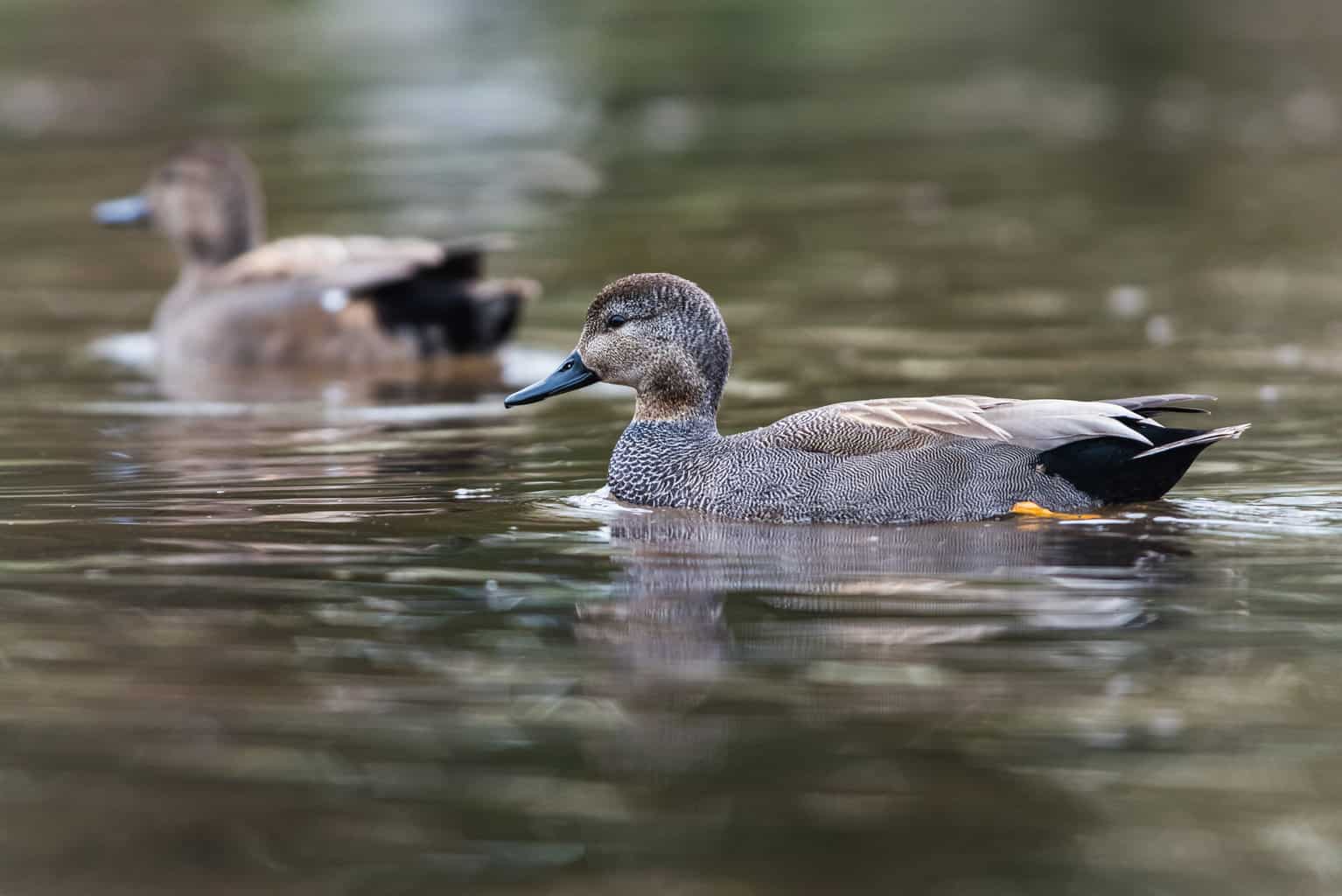
- Mareca strepera
- Length: 19 – 23 in (48 – 58 cm)
- Weight: 35.27 oz (1000 g)
- Wingspan: 31 – 36 in (79 – 91 cm)
Gadwall males are mostly gray-brown, but they have a black spot on the tail. Females, on the other hand, have patchy coloring in shades of brown. They have white markings along their tails, but those can be difficult to see if the duck is in the water.
They tend to find marshes and city parks for the winter, as long as there are plenty of aquatic grasses. Gadwall are excellent at camouflage, and they hide in the dry, winter grasses along these marshes and ponds.
In most of Kansas, Gadwall are winter residents. However, there are a few places along the Arkansas River where communities of Gadwall spend the breeding season, too.
Greater Scaup (Diving Duck)
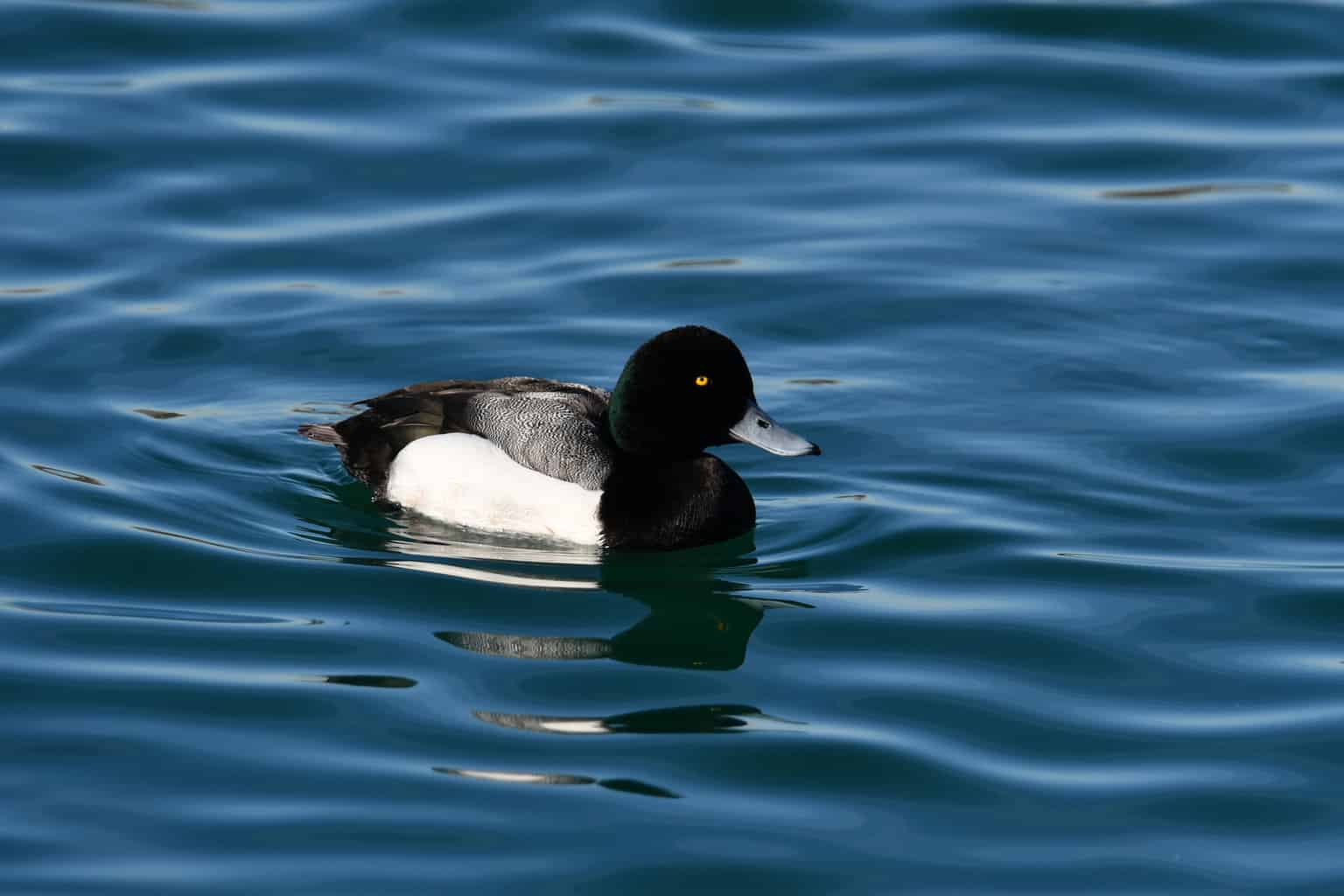
- Aythya marila
- Length: 15-22 inches
- Weight: 1.5-2.9 pounds
- Wingspan: 28-33 inches
Greater Scaup are sometimes called the Bluebill, as they have a thick, slate-blue bill that can be seen from a distance. Males have white bodies with a back that is barred in brown and black. Females are light brown, but their heads are much darker.
They are one of two kinds of Scaup that are found in Kansas — we’ll get to Lesser Scaup later in our list!
They can be seen in the western half of Kansas during their migration windows in the spring and fall. Some spend the winter in the eastern half of the state. Note that during the winter, the male’s coloring becomes more muted, so he looks more like a female.
Green-Winged Teal Duck (Dabbling Duck)
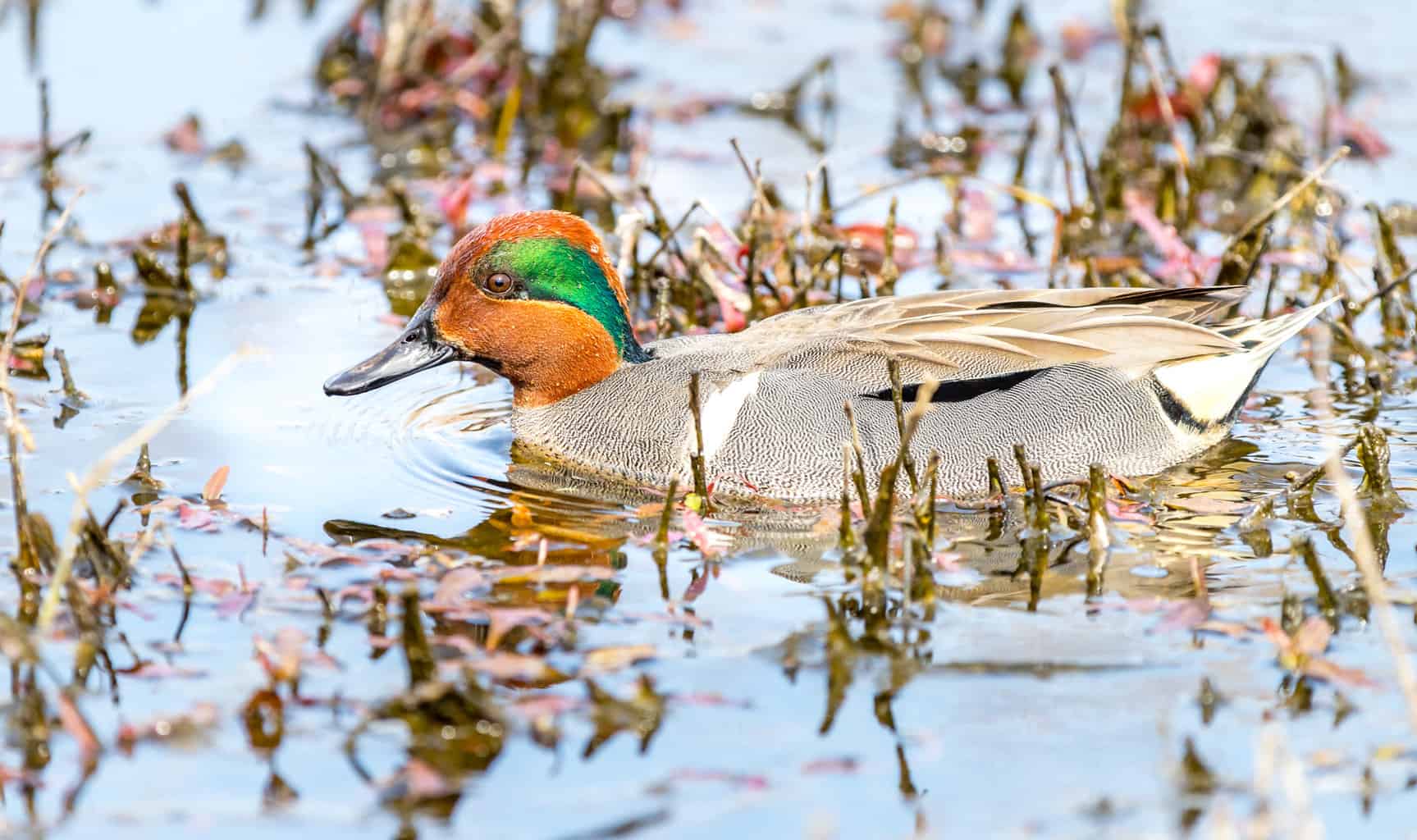
- Anas crecca
- Length: 12.2 – 15.3 in (31 – 39 cm)
- Weight: 4.9 – 17.6 oz (140 – 500 g)
- Wingspan: 20.5 – 23.2 in (52 – 59 cm)
Teal Ducks are small, including Green-Winged Teal Ducks. The male has a green band of color that runs from his eyes to the back of his head. Otherwise, his head is dark brown, and the rest of his body features tiny black bars.
The female is brown, and she has a yellow streak along her tail. Both sexes have an iridescent green speculum.
Green-Winged Teal Ducks spend the winter along the southern border of Kansas. In the rest of the state, they may be spotted during their winter or spring migration.
Although they are usually seen in small groups of about 15 individuals, Green-Winged Teal Ducks will sometimes gather with thousands of others. It can be quite a sight!
King Eider (Sea Duck)
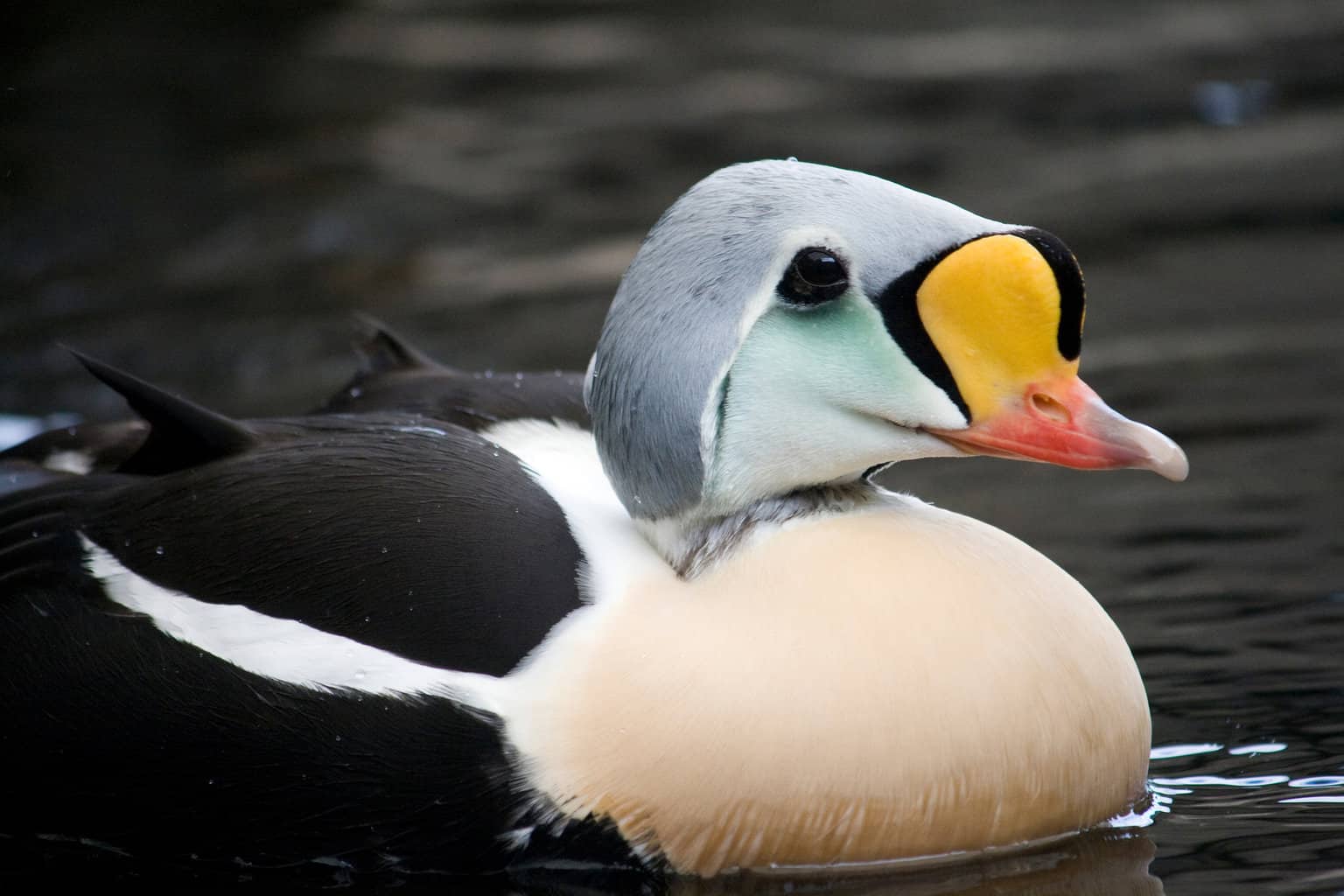
- Somateria spectabilis
- Length: 20 – 28 in (50 – 70 cm)
- Weight: 2.6 – 4.6 lb (1.2–2.1 kg)
- Wingspan: 34 – 40 in (86 – 102 cm)
The King Eider, like the Common Eider, has only one recorded occurrence in Kansas. An immature male was documented in Kansas in 1940.
The male King Eider is immediately identifiable, thanks to his unique head shape. The oblong head has a very gradual slope forward into a large orange plate that sits above his bill. This bulge is brightly colored in orange, black, and red.
His crown is light blue, and the rest of his body is black and white.
The female has a much more subtle appearance. Her body is mostly brown with darker brown barring. She has a pale cheek and neck and an all-black bill.
Both sexes have very strong, thick necks and live most of their lives in seawater.
Lesser Scaup (Diving Duck)
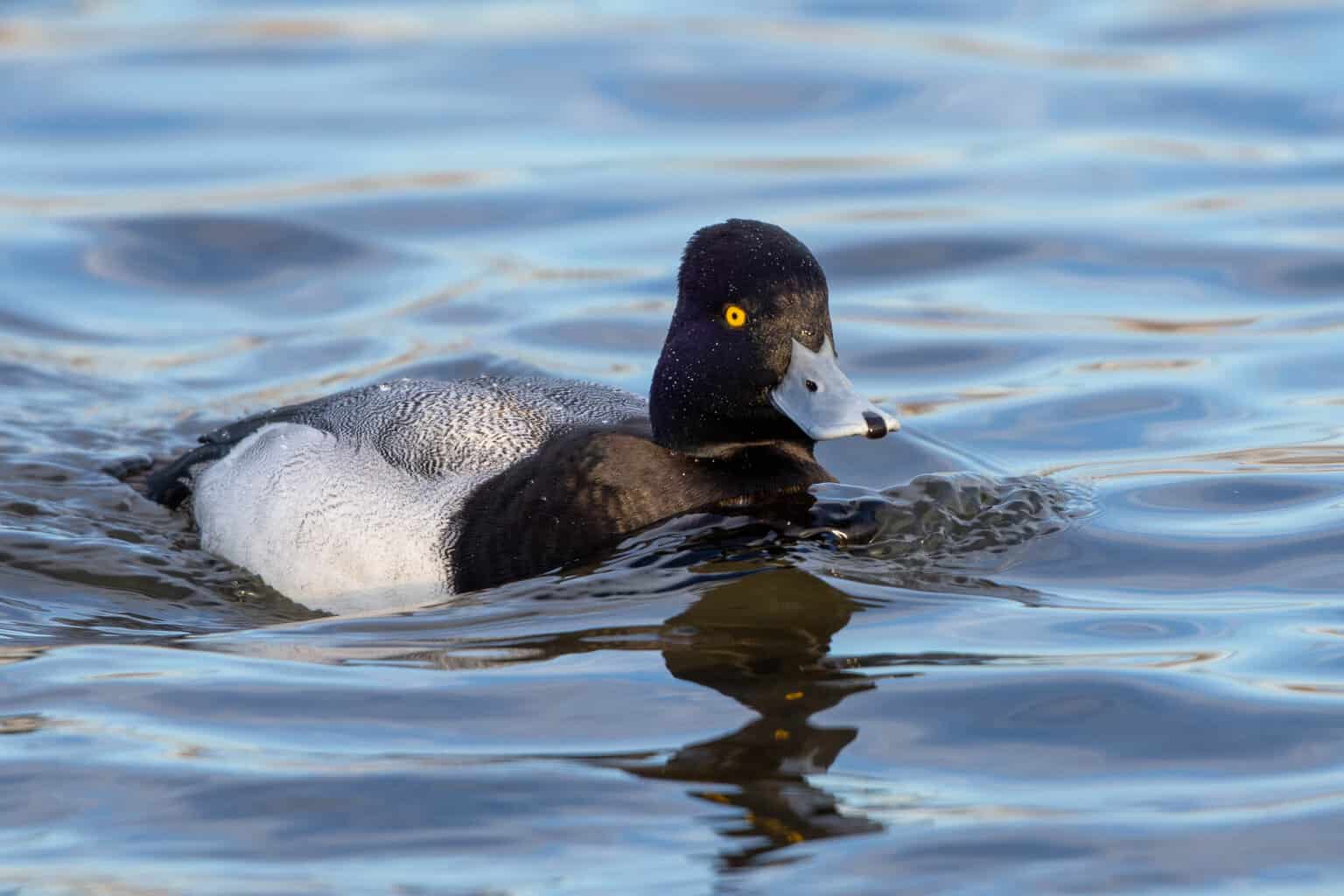
- Aythya affinis
- Length: 15 – 18 in (38 – 49 cm)
- Weight: 40.77 oz (1155 g)
- Wingspan: 24 – 33 in (61 – 84 cm)
Lesser Scaup have a pretty similar appearance to Greater scaup. The male’s head is purplish-black, and he has white sides with thin gray bars. His eyes are golden yellow. The female is dark brown with a white patch on each cheek.
However, Lesser Scaup have a few feathers atop their heads, making them look like they have stray hairs.
Oklahoma is one of many states that is home to both Greater and Lesser Scaup. In the panhandle and across northern Oklahoma, you’ll see them when they migrate between summer and winter habitats.
They are strictly migratory in Kansas, visiting in the spring or fall when they are on their way to their breeding or winter grounds.
One really interesting trait about the Lesser Scaup is its ability to “play dead” to avoid predators. This defense mechanism appears to be unique to Lesser Scaup.
Long-Tailed Duck (Sea Duck)
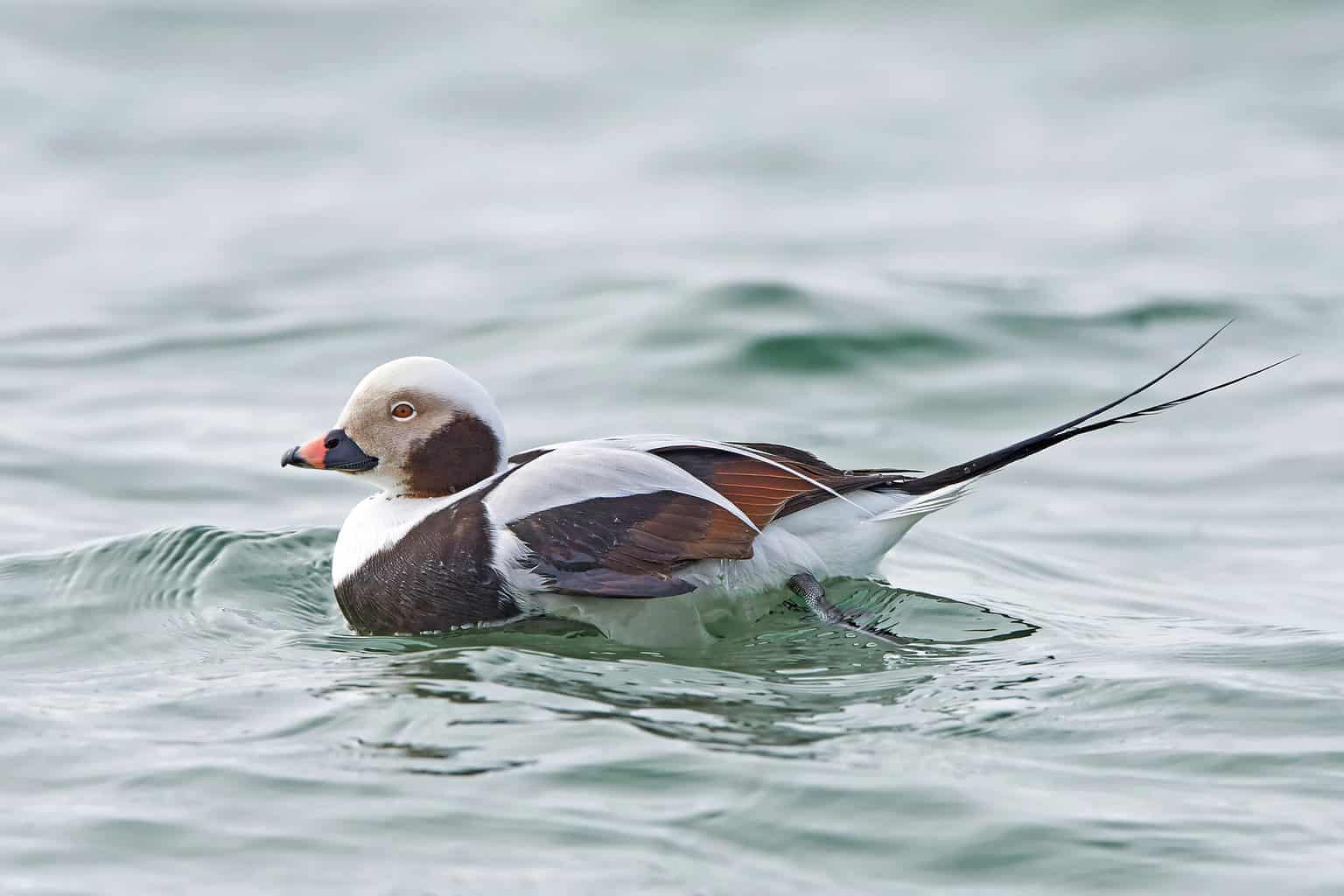
- Clangula hyemalis
- Length: 15 – 22 in (38 – 56 cm)
- Weight: 31.74 oz (900 g)
- Wingspan: 26 – 31 in (66 – 79 cm)
The Long-Tailed Duck is a fascinating example of extreme color change between breeding and non-breeding seasons.
Long-Tailed Duck males are black and white, but their white and black coloring completely reverses itself after the breeding season. Anything that was black turns white and vice versa.
Female ducks rarely change appearance from one season to the next, but Long-Tailed females do! They are brown and white, and their coloring also reverses during their fall and spring molts.
Long-Tailed Ducks are North America’s deepest diving ducks, submerging themselves up to 200 feet under the water in pursuit of their food. They are spotted in Kansas more frequently than other sea ducks, like the Eiders, but they are still only accidental visitors here.
They have been seen in Kansas during their migration windows, particularly in November, and especially in Cheyenne Bottoms and Milford Reservoir.
Mallard (Dabbling Duck)
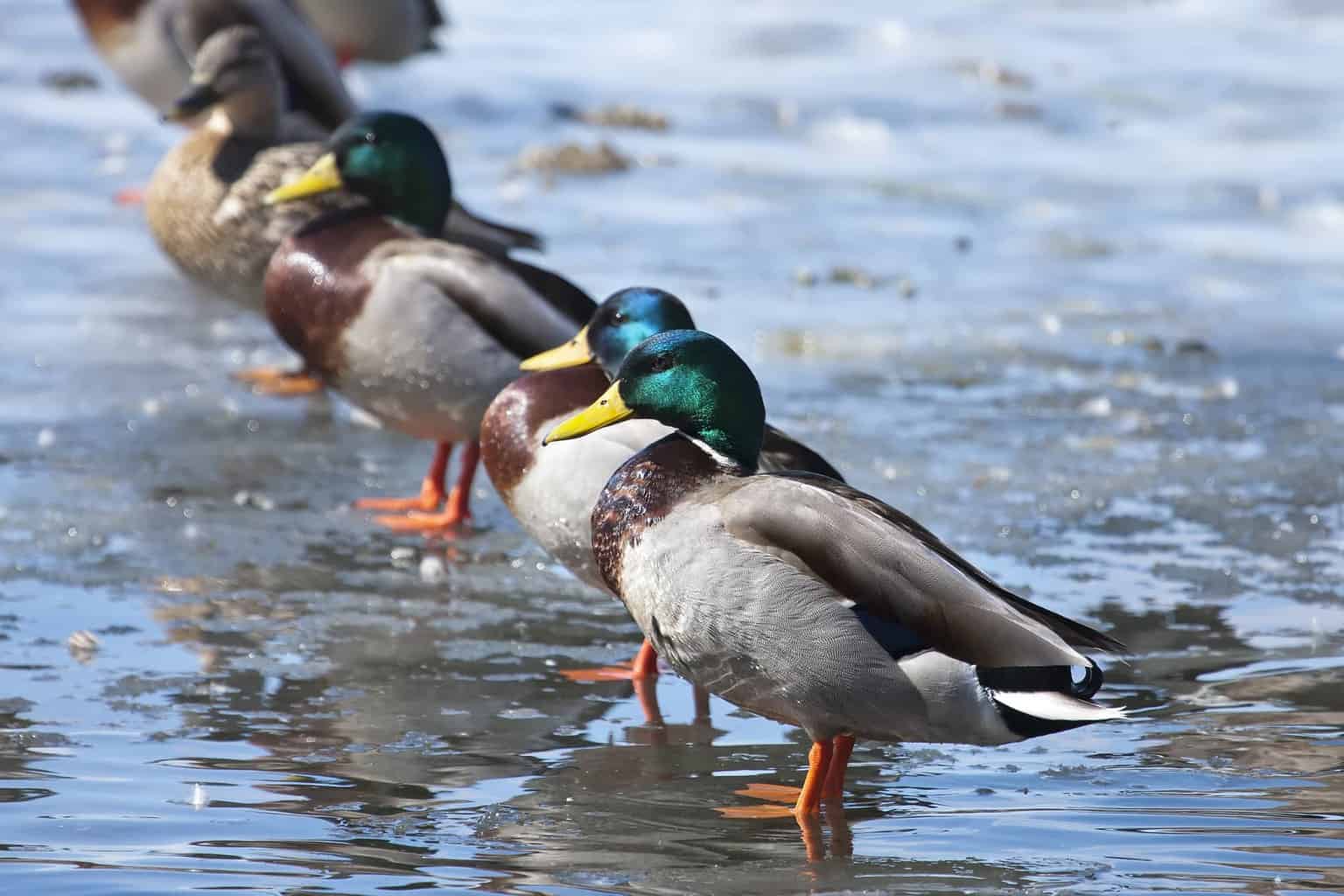
- Anas platyrhynchos
- Length: 19.7 – 25.6 in (50 – 65 cm)
- Weight: 35.3 – 45.9 oz (1000 – 1300 g)
- Wingspan: 32.3 – 37.4 in (82 – 95 cm)
As the most common duck in the world, the Mallard is absolutely iconic. You can find them in home decor, on jewelry pendants, in paintings, and even in toys and stuffed animals.
- Love, play, cuddle and squeeze! Squishmallows are the softest, cutest plush toys around!
- Meet Avery the Mallard Duck! Featuring soft plush fabric, Squishmallows have their own style and personality encouraging fun and...
- The snuggle is real! The large squishy plush makes for the perfect cuddle companion! These super soft, collectible plush toys are...
Last update on 2024-04-20 / Affiliate links / Images from Amazon Product Advertising API
The male has an iridescent head and brown breast which are separated by a thin white neckband. He has a blue speculum and a bright yellow bill.
Female Mallards have a streaked and mottled appearance in various shades of brown.
Because Mallards are incredibly territorial, people sometimes have mixed feelings about them. Even though they are beautiful, their behaviors can be troubling to birders. They will fight each other over territory, and males behave in sexually aggressive ways toward females.
Mallards are a great reminder that animals often live by their own set of rules.
Mallards are found throughout Kansas, especially in the winter. They are so commonplace that they make up a huge portion of the ducks that are hunted annually here.
Mottled Duck (Dabbling Duck)
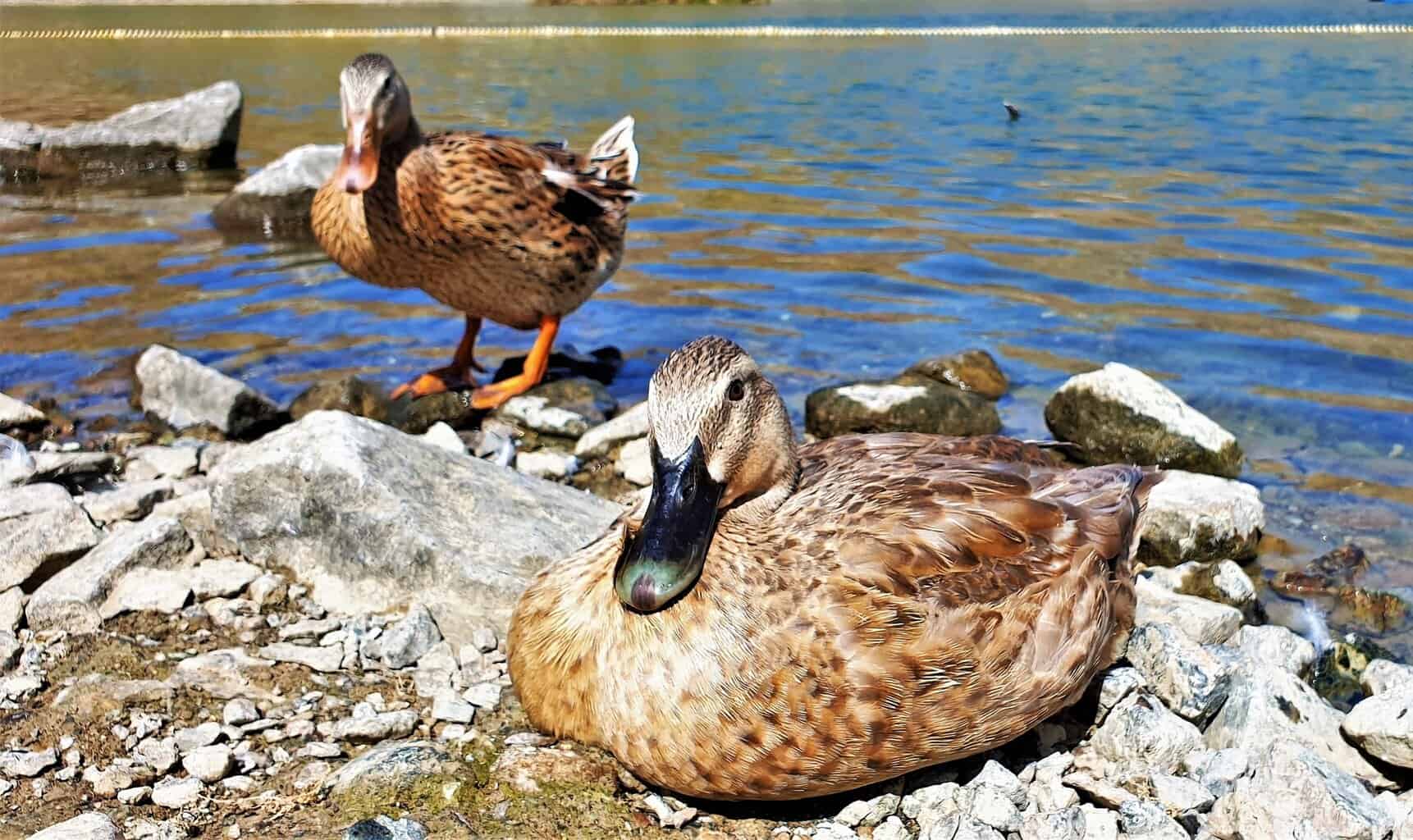
- Anas fulvigula
- Length: 18.5-21 inches
- Weight: 24.7-40.6 ounces
- Wingspan: 31.5-34.3 inches
Mottled Ducks are pretty rare in Kansas, as their usual habitat is along the Gulf Coast and the southern Atlantic Coast in Florida. However, some individuals travel outside that limited range, and Kansas is included in their less common breeding territory
Male and female Mottled Ducks have a similar appearance to one another: streaked feathers, dark to light brown coloring, and yellow bills. Females are just a little bit more subtle in their coloring. Additionally, the female’s bill may have a hint of green.
The Audubon Society states, “Mottled Ducks are almost never seen in large flocks, generally traveling in pairs or small groups. A major threat to their survival is the release of numerous pet Mallards in Florida and elsewhere in the southeast; these feral birds interbreed with Mottled Ducks, diluting the wild population of the latter.”
Mottled Ducks are pretty rare in Kansas, as their usual habitat is along the Gulf Coast and the southern Atlantic Coast in Florida. However, some individuals travel outside that limited range, and Kansas is included in their less common breeding territory.
Northern Pintail (Dabbling Duck)
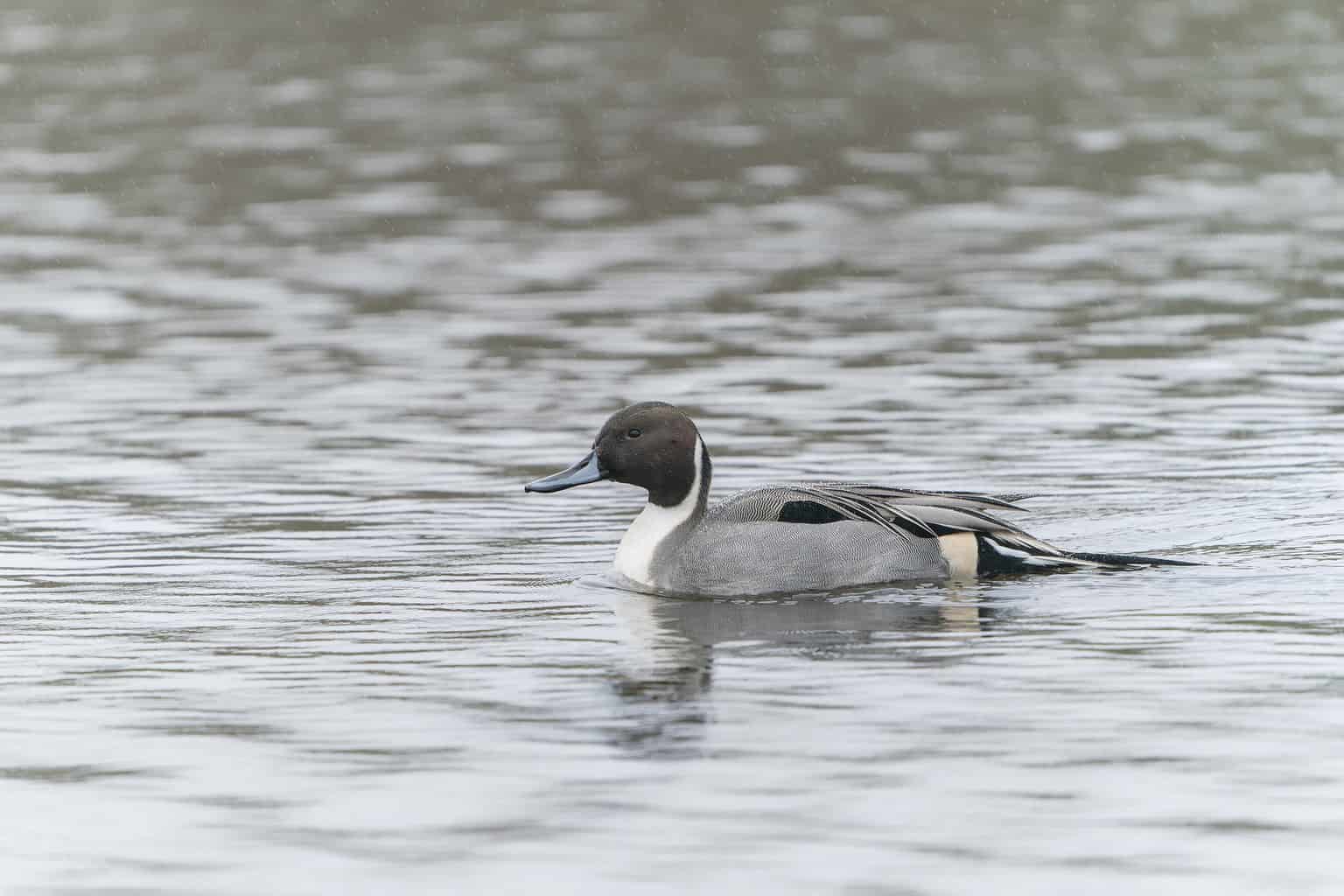
- Anas acuta
- Length: 20 – 26 in (51 – 66 cm)
- Weight: 36.33 oz (1030 g)
- Wingspan: 29 – 35 in (74 – 89 cm)
The male Northern Pintail’s long, pointed tailfeathers give him his name. He loses these feathers after the breeding season, but his tail is still pretty pointy compared to other ducks.
He has a brown head with a white stripe running down his neck. His body is white, gray, and black. He also has a green speculum.
The female has a pointed tail, too. Hers is not as long as his. She is light brown with a dark brown scaled pattern.
Their long necks allow them to reach deeper food than many other dabbling ducks.
In the northwest corner of Kansas, Northern Pintails are year-round residents. Along the rest of the northern border, they are predictably present during their migration. In the rest of the state, they are winter residents.
As early-season migrants, they usually arrive in Kansas before other ducks that will winter here.
Northern Shoveler (Dabbling Duck)

- Spatula clypeata
- Length: 17.3 – 20.1 in (44 – 51 cm)
- Weight: 14.1 – 28.9 oz (400 – 820 g)
- Wingspan: 27.2 – 33.1 in (69 – 84 cm)
The green head of a Northern Shoveler male looks, at first glance, a bit like a Mallard’s head. However, they look quite different other than the head.
The Northern Shoveler has a very broad and thick black bill, which he uses to “shovel” food-filled water into his mouth. He lets the water strain out and keeps the food, whether that is aquatic plants or insects and invertebrates.
Females have the same bill for the same feature, but the female’s bill is brown instead of black.
Northern Shoveler females will defecate on their nests to deter predators from stealing their eggs. This is not unique to Northern Shovelers, but it seems to be something that they do consistently, especially if they are startled.
They consistently migrate through the northern two-thirds of Kansas and spend the winter along the southern border.
Redhead (Diving Duck)
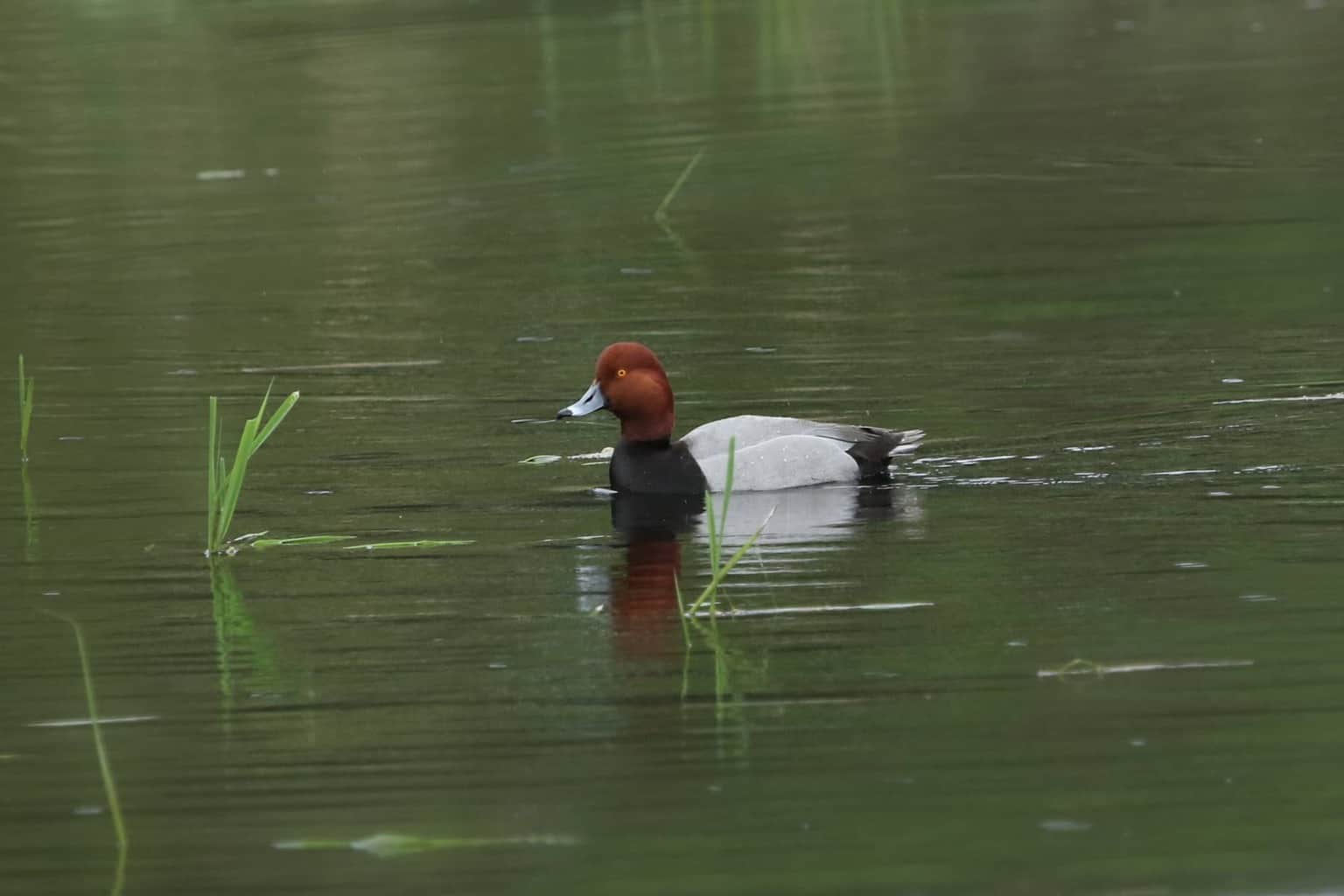
- Aythya americana
- Length: 18 -22 in (46 – 56 cm)
- Weight: 43.03 oz (1219 g)
- Wingspan: 29 – 35 in (74 – 89 cm)
Redhead Ducks are easy to identify. The male has a very dark reddish-brown head atop a gray and black body. His bill will look either dark gray or slate blue, and it is tipped in black.
Female Redheads are mostly unmarked with splotchy light brown coloring. She may have a pale or white patch between her eyes and the base of her bill.
Redhead Ducks are occasional practitioners of brood parasitism, which means they lay their eggs in other Redhead nests instead of just laying them in their own.
They are strictly migratory in Kansas as they move between their mostly western breeding territory and their mostly southern wintering territory.
Ring-Necked Duck (Diving Duck)
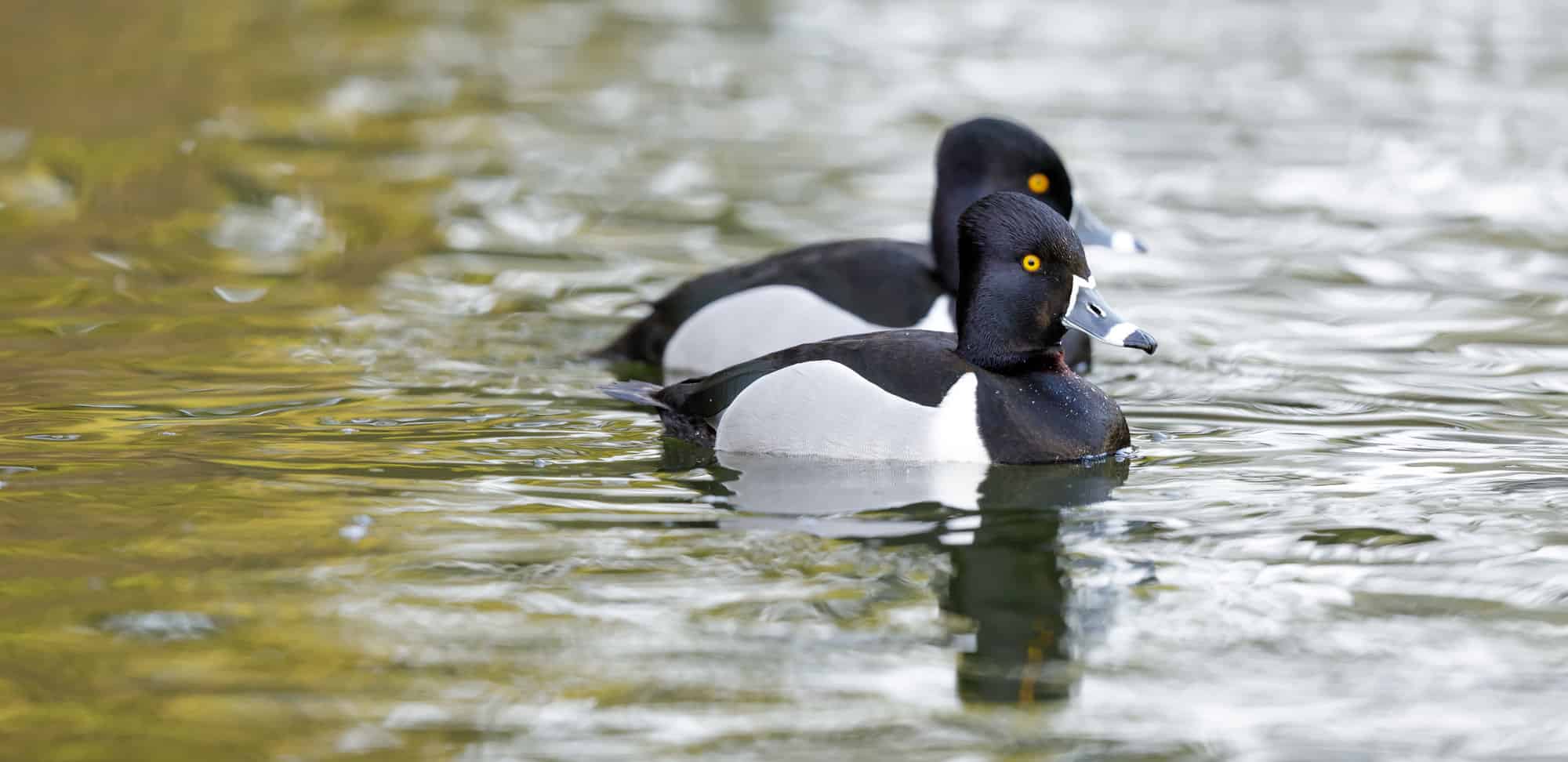
- Aythya collaris
- Length: 14 – 18 in (36 – 46 cm)
- Weight: 32.09 oz (909 g)
- Wingspan: 24 – 30 in (61 – 76 cm)
If there were ever a duck with a poorly chosen name, it would be the Ring-Necked Duck. The male Ring-Necked Duck has an incredibly subtle, almost indistinguishable copper ring around his otherwise dark neck.
Perhaps the naturalists who gave this species its English name in the 1800s thought this ring was noteworthy, but most birders can’t even see it when they look at this duck up close, let alone from a distance.
Males and females do have a white band around their bill, near the tip. Males also have a thin white stripe that outlines the base of their bill.
Males are black-chested and have a black back and head, too. They also have a white belly. Females are brown with gray faces. Her eyes are outlined in white.
This is another migration-only duck in Kansas. You will not see them nesting in the state, as they are on their way to and from other regions.
Ruddy Duck (Diving Duck)
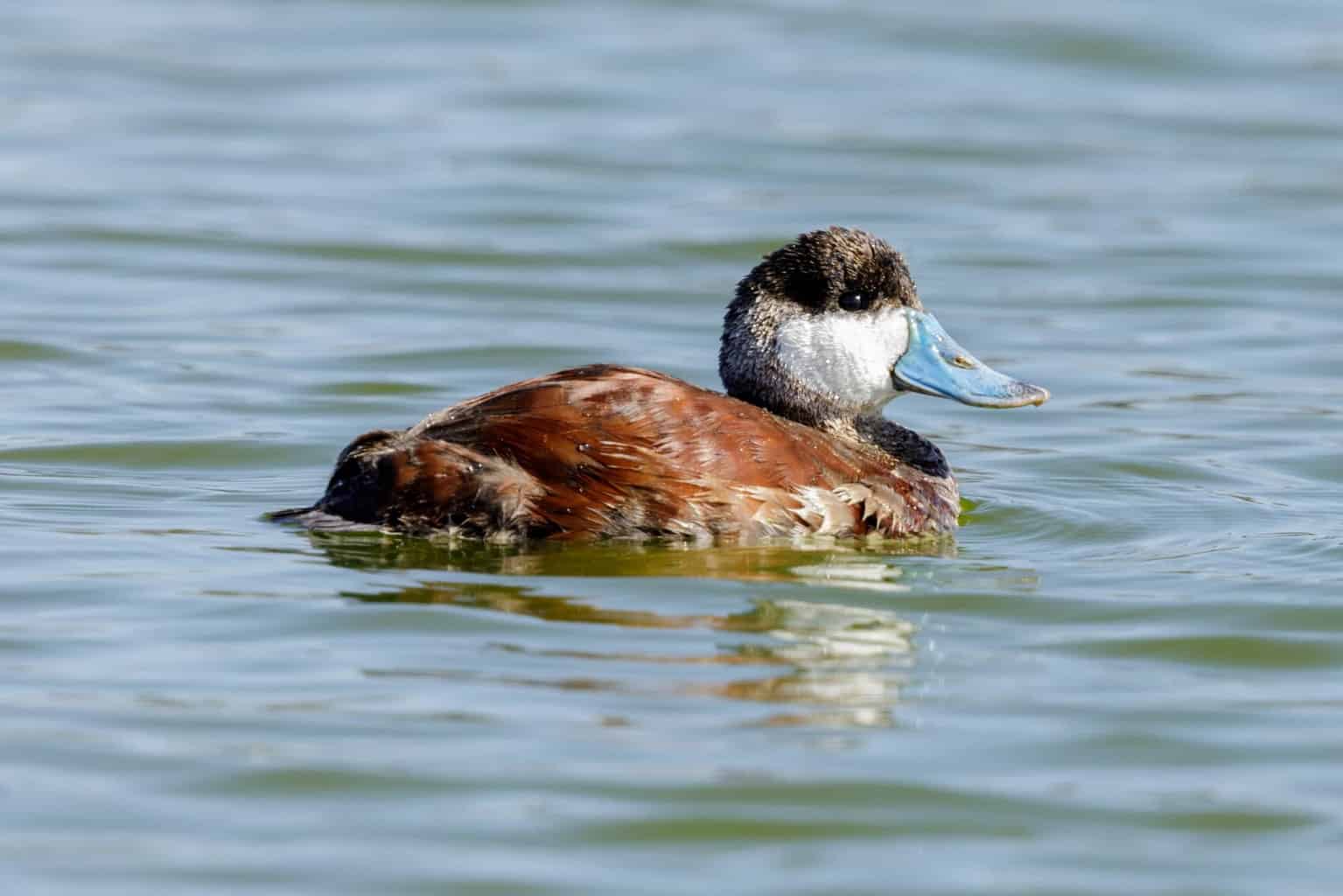
- Oxyura jamaicensis
- Length: 14 – 16 in (35.56 – 40.64 cm)
- Weight: 28.04 oz (795 g)
- Wingspan: 21 – 24 in (53 – 61 cm)
The male Ruddy Duck has a vibrant summer appearance: reddish-brown feathers over most of his body, a black crown that starts just below his eyes, a thick, baby blue bill, and a large white cheek patch. During the winter, he fades to a dull gray over most of his body.
The female has a brown body with a dark brown cap. Her cheek patch is gray, and her bill is black.
Most of Kansas will only see Ruddy Ducks as they migrate, but they breed in the northwestern corner of the state.
The female Ruddy Duck will build a nest out of the grasses and plants that grow along the water, often with a protective covering of grasses and leaves over the top.
Surf Scoter (Sea Duck)
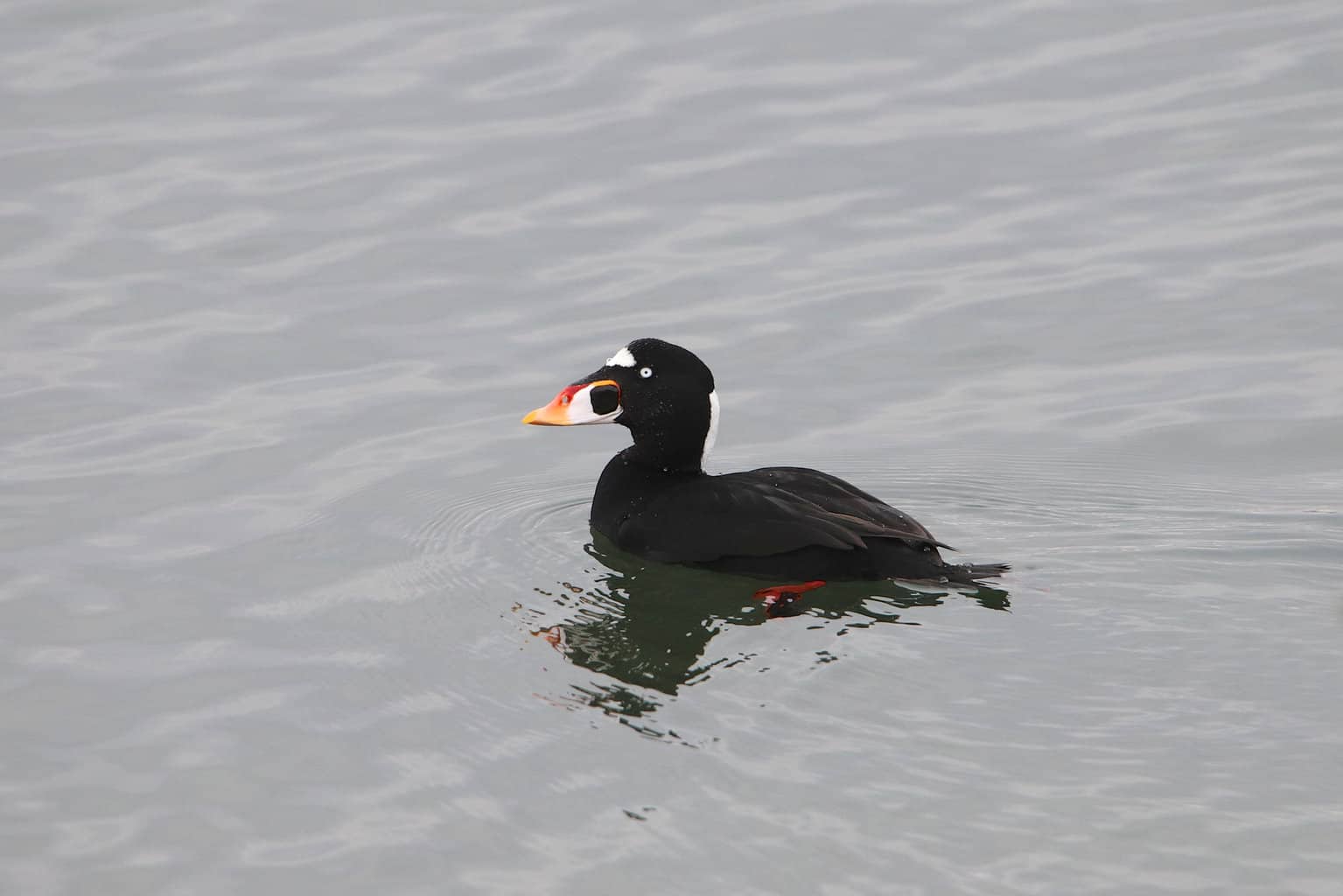
- Melanitta perspicillata
- Length: 17 – 21 in (43 – 53 cm)
- Weight: 35.27 oz (1000 g)
- Wingspan: 30 – 36 in (76 – 91 cm)
Scoters are likely to capture your attention, thanks to this duck’s interesting bill.
The male Surf Scoter is almost entirely black, and he has a big forehead that slopes down to an orange, yellow, and red bill that is much taller than the bill of a typical duck. He also has a few noticeable white patches: above his bill and on the base of his neck.
The female’s bill is not as large, and it is dark gray instead of colorful. She has white patches behind her eyes and on the back of her neck.
Surf Scoters usually live on the coasts. They breed across northern Canada and in Alaska, and then they migrate to the North American coasts for the winter.
They are uncommon in Kansas, but they appear to be lingering longer on the deep reservoirs in central and western Kansas.
White-Winged Scoter (Sea Duck)
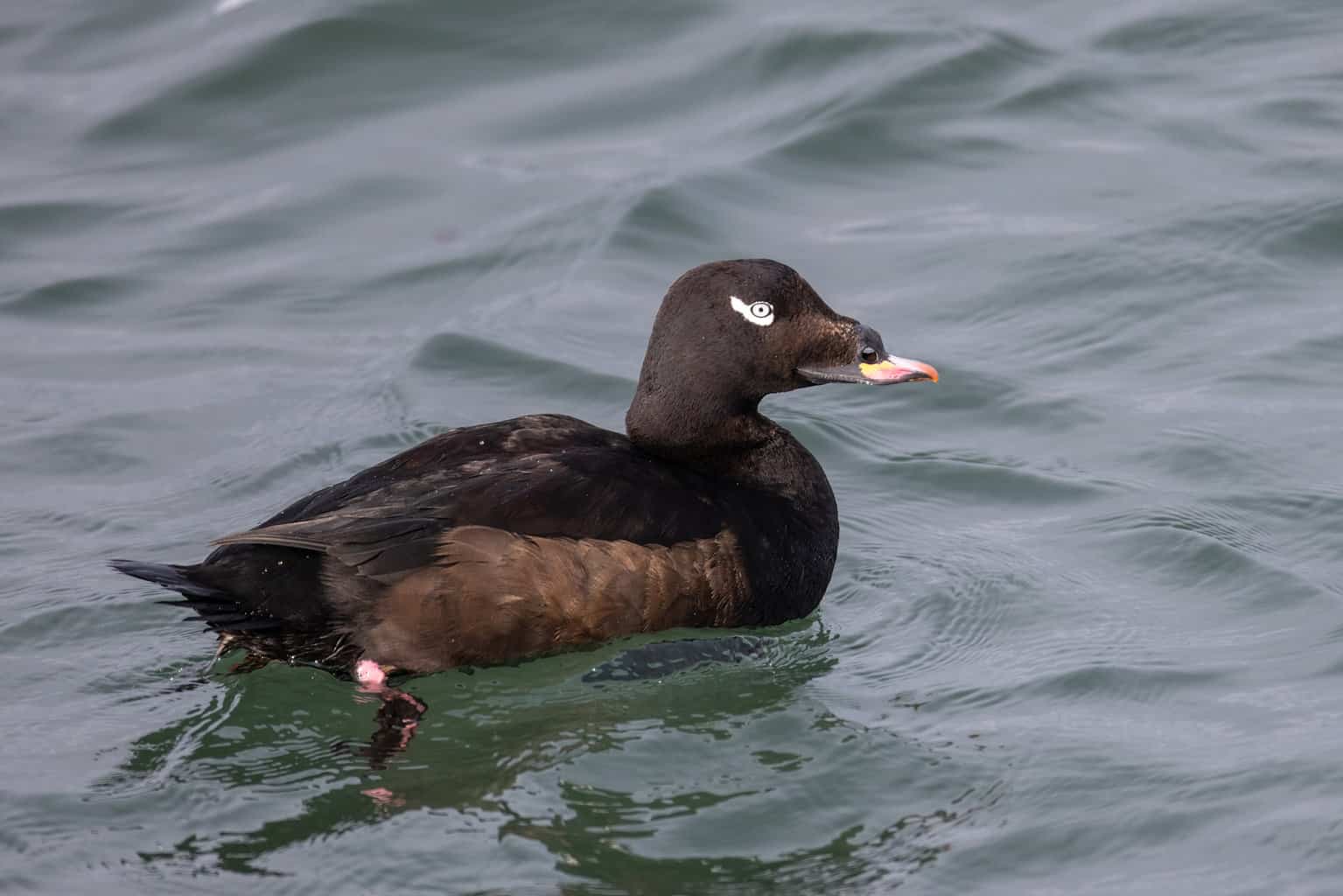
- Melanitta deglandi
- Length: 19 – 24 in (48 – 61 cm)
- Weight: 62.4 oz (1768 g)
- Wingspan: 33 – 41 in (84 – 104 cm)
White-Winged Scoters, like Surf Scoters, have a large, thick bill. That distinctive “scoter look” gives them a thick, bulging bill at the base and a thinner tip.
Males and females look similar to one another. They are mostly black, although the male has a white stripe on his wings, and the female does not. He has a white “reverse comma” marking over his eyes, too. Females may look more like dark brown than black.
White-Winged Scoters show up in Kansas pretty rarely. Those rare visitors have been documented most often between October and December.
Wood Duck (Dabbling Duck)
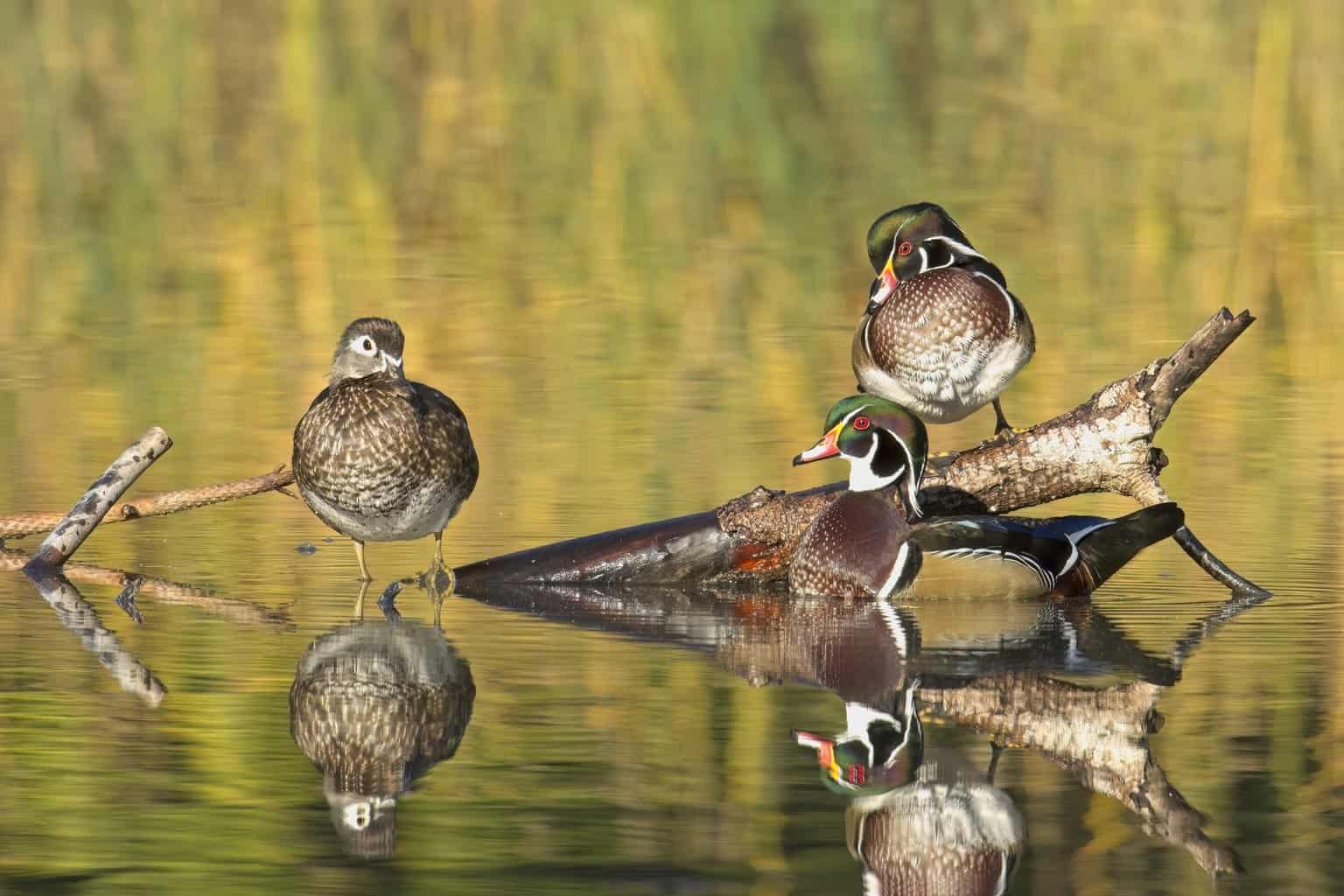
- Aix sponsa
- Length: 18.5 – 21.3 in (47 – 54 cm)
- Weight: 16.0 – 30.4 oz (454 – 862 g)
- Wingspan: 26.0 – 28.7 in (66 – 73 cm)
The male Wood Duck has a shiny, iridescent green head. Unlike the Mallard’s green head, the Wood Duck has a dramatic crest at the base of his head. He has a brown back and tail, a dappled, chestnut-brown breast, and a series of white stripes all over his body.
The female has a blue speculum, a gray head, and a brown body.
They are cavity dwellers who choose trees that are very close to the water. They are usually found along rivers, swamps, ponds, and wetlands. Although they eat a diet that is mostly made up of seeds and nuts, they will also eat aquatic insects, plants, salamanders, and tadpoles.
Wood Ducks lay two clutches of eggs every year, which is a unique breeding behavior that may contribute to how plentiful they are.
You won’t find a Wood Duck along the northern edge of Kansas, but they are winter residents in much of the state.
Finding Ducks in Kansas
If nothing else, I hope this list has shown you just how many ducks you may be able to find in Kansas! Especially if you have some great gear, like a good pair of binoculars, a spotting scope, and an easily-accessed notebook and pencil!
Although some are quite rare (like the Eiders and Scoters), others are incredibly common. You can turn duck-sighting in Kansas into a great hobby! Whether you’re someone who lives in Kansas or is just visiting, there are plenty of ducks to look for.
Of course, there are lots of other birds here, too! Check out 25 more birds in Kansas in our state bird guide! Birding in Kansas is a rewarding pastime for hobbyists, including those who are brand new to birding and those who have been doing this for years.
One option is to check out the Kansas Birding Trails, which will help you find ducks, hummingbirds, blackbirds, raptors, songbirds, and so much more! Birding is a great way to get outside and enjoy nature, all year long.
Once you start identifying the interesting ducks and birds in Kansas, you may not want to stop!

